Contents
- 1. User manual 1 of 3
- 2. User manual 2 of 3
- 3. User manual 3 of 3
User manual 1 of 3
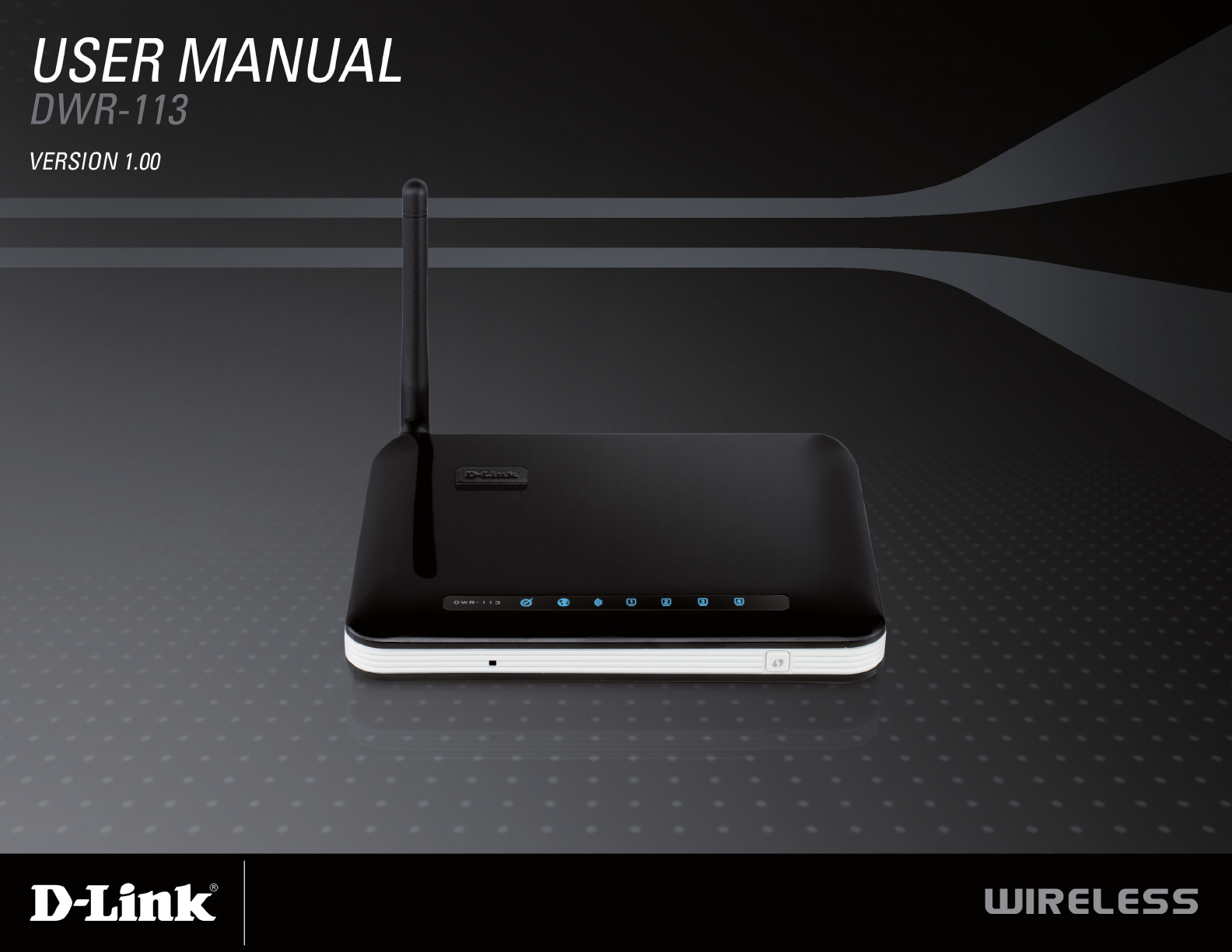

iD-Link DWR-113 User Manual
D-Link reserves the right to revise this publication and to make changes in the content hereof without obligation to
notify any person or organization of such revisions or changes.
Trademarks
D-Link and the D-Link logo are trademarks or registered trademarks of D-Link Corporation or its subsidiaries in
the United States or other countries. All other company or product names mentioned herein are trademarks or
registered trademarks of their respective companies.
Copyright © 2010 by D-Link Systems, Inc.
All rights reserved. This publication may not be reproduced, in whole or in part, without prior expressed written
permission from D-Link Systems, Inc.
Preface

iiD-Link DWR-113 User Manual
Table of Contents
Preface...........................................................................i
Trademarks .............................................................. i
Product Overview ........................................................ 1
Package Contents ...................................................1
System Requirements .............................................1
Introduction ..............................................................2
Hardware Overview ................................................. 3
Back Panel .........................................................3
Front Panel and LEDs ....................................... 4
Installation ....................................................................5
Connect to Your Network ........................................5
Wireless Installation Considerations ........................ 6
Conguration ............................................................... 7
Web-based Conguration Utility .............................. 7
Setup Wizard ........................................................... 8
Internet Connection Setup Wizard ..................... 8
Manual Internet Connection Setup ..................12
Internet Connection .........................................13
Internet Connection Type ................................ 13
Dynamic IP (DHCP) ......................................... 14
PPPoE .............................................................15
PPTP ...............................................................16
L2TP ................................................................17
3G ....................................................................18
Static IP ...........................................................19
Wireless Settings .............................................20
Network Settings ..............................................22
Router Settings ............................................22
DHCP Server Settings .................................23
Virtual Server ...................................................24
Application Rules .............................................25
QoS Engine .....................................................26
MAC Address Filter .......................................... 27
URL Filter .........................................................28
Outbound Filter ................................................29
Inbound Filter ................................................... 30
SNMP .............................................................. 31
Routing ............................................................32
Advanced Wireless ..........................................33
Advanced Network ...........................................34
Admin ...............................................................35
Time ................................................................. 36
Syslog ..............................................................37
E-mail Settings .................................................38
System ............................................................. 39
Firmware .......................................................... 40
Dynamic DNS ..................................................41
System Check ..................................................42
Schedules ........................................................43
Device Information ........................................... 44
Table of Contents

iiiD-Link DWR-113 User Manual
Table of Contents
Logs .................................................................45
Statistics ..........................................................46
Wireless ...........................................................47
Support ............................................................48
Wireless Security.......................................................49
What is WEP? .......................................................49
Congure WEP ...................................................... 50
What is WPA? .......................................................51
Congure WPA-PSK .............................................52
Congure WPA (RADIUS) ..................................... 53
Connect to a Wireless Network ................................ 54
Using Windows Vista™ .........................................54
Congure Wireless Security ............................ 55
Using Windows® XP ............................................... 57
Congure WEP ................................................58
Congure WPA-PSK ........................................60
Troubleshooting ........................................................ 62
Wireless Basics ......................................................... 64
What is Wireless? .................................................. 65
Tips ........................................................................ 67
Wireless Modes ..................................................... 68
Networking Basics .................................................... 69
Check your IP address ..........................................69
Statically Assign an IP address .............................70
Technical Specications........................................... 71

1D-Link DWR-113 User Manual
Section 1 - Product Overview
• D-Link DWR-113 3G Wi-Fi Router
• Power Adapter
• Manual and Warranty on CD
• External Wi-Fi antenna
System Requirements
• A compatible 3G USB modem
• Computers with Windows®, Macintosh®, or Linux-based operating systems with an installed Ethernet
adapter
• Internet Explorer Version 6.0 or Netscape Navigator™ Version 6.0 and above (for conguration)
Product Overview
Note: Using a power supply with a different voltage rating than the one included with the DWR-113 will cause damage and
void the warranty for this product.
Package Contents

2D-Link DWR-113 User Manual
Section 1 - Product Overview
Introduction
The D-Link 3G Wi-Fi Router allows users to access worldwide mobile broadband networks. Once connected, users
can transfer data, stream media, and send SMS messages. Simply connect your USB modem and share your 3G
Internet connection through a secure 802.11n wireless network or using the 10/100 Ethernet port.
While accessing your 3G Internet connection, you will still have the ability to respond to SMS messages.
The 3G Wi-Fi Router can be installed quickly and easily almost anywhere. This router is great for situations where
an impromptu wireless network must be set up, or wherever conventional network access is unavailable. The
DWR-113 can even be installed in buses, trains, or boats, allowing passengers to check e-mail or chat online while
commuting.

3D-Link DWR-113 User Manual
Section 1 - Product Overview
Hardware Overview
Back Panel
Port Function
USB Port Connects to a USB modem.
LAN Port Connects to wired computers or devices.
WAN Port Connects to the Internet.
Power Port Connects to the power adapter.
USB
LAN 4
LAN 3
LAN 2
LAN 1
WAN
POWER
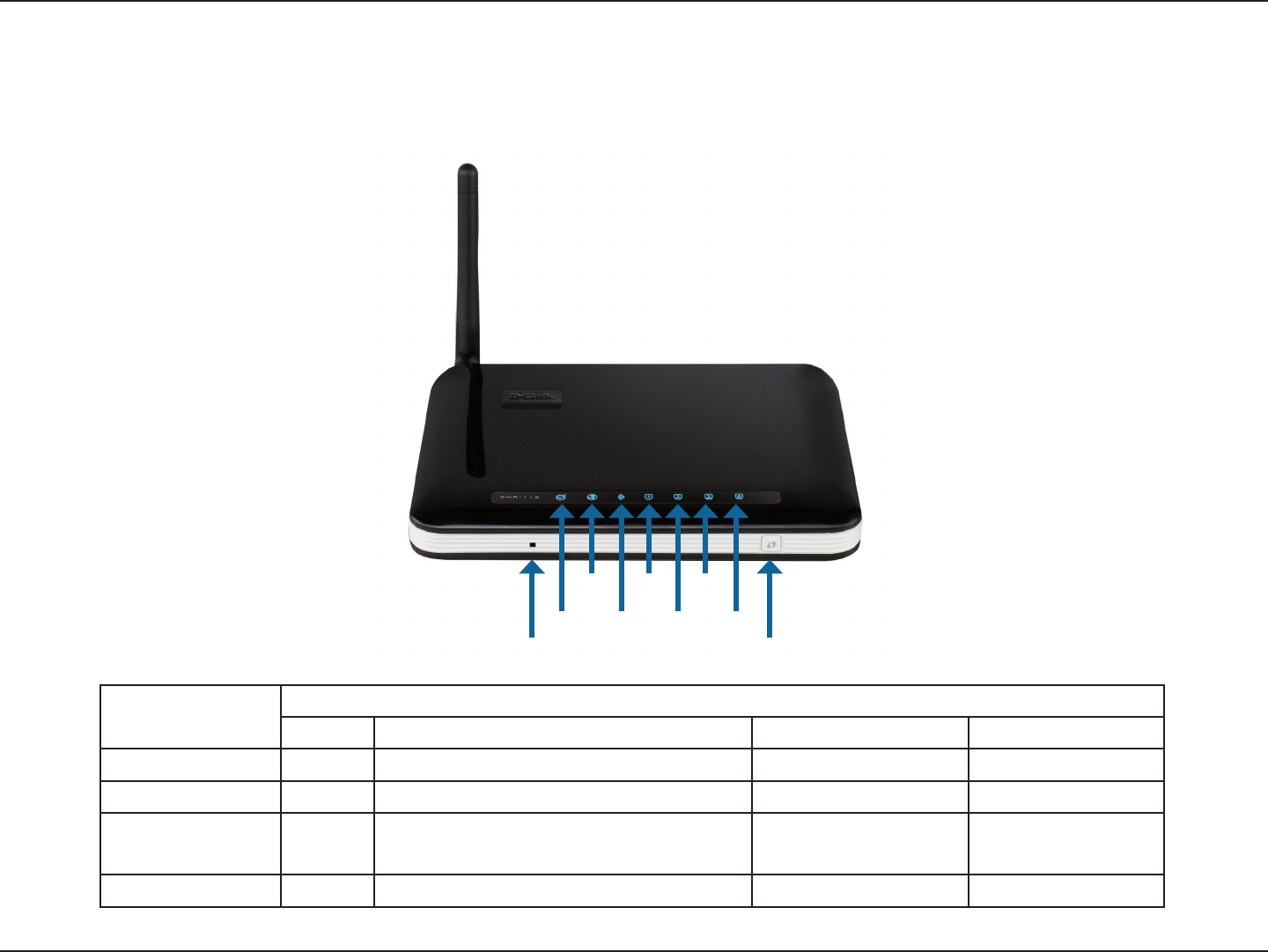
4D-Link DWR-113 User Manual
Section 1 - Product Overview
Hardware Overview
Front Panel and LEDs
3G
WAN
Wi-Fi
LAN
LAN
LAN
LAN
WPS BUTTONRESET BUTTON
LED Description
Color Solid Blinking Blinking (Fast)
3G Green 3G connection established Data transmitting -
WAN Green WAN connection established Data transmitting -
Wi-Fi Green Wi-Fi active and available Data transmitting Device in WPS
mode
LAN 1 - LAN 4 Green Ethernet connection established Data transmitting -

5D-Link DWR-113 User Manual
Section 2 - Installation
Installation
This section will guide you through the installation process. Placement of the router is very important. Do not place the router in an enclosed
area such as a closet, cabinet, or in an attic or garage.
Connect to Your Network
Note: Ensure that your DWR-113 3G Wi-Fi Router is disconnected and powered off before performing the installation steps below.
1. Connect a USB modem to the USB port on the back of the router.
2. Insert a LAN network cable into the LAN port on the back of the router. Plug the other end of the LAN cable into the LAN port of your
computer or laptop. The Ethernet LED will turn green if the Ethernet connection is successfully established.
Note: The DWR-113 3G Wi-Fi Router LAN Port is “Auto-MDI/MDIX.” Therefore, patch or crossover Ethernet cables can be used.
3. Congure the device using the setup utility.

6D-Link DWR-113 User Manual
Section 2 - Installation
Wireless Installation Considerations
The DWR-113 can be accessed using a wireless connection from virtually anywhere within the operating range of your wireless network.
Keep in mind, however, that the quantity, thickness and location of walls, ceilings, or other objects that the wireless signals must pass
through, may limit the range. Ranges vary depending on the types of materials and background RF (radio frequency) noise in your home
or ofce. The key to maximizing the wireless range is to follow these basic guidelines:
1. Minimize the number of walls and ceilings between the D-Link router and other network devices. Each wall or ceiling can
reduce your adapter’s range from 3 to 90 feet (1 to 30 meters).
2. Be aware of the direct line between network devices. A wall that is 1.5 feet thick (0.5 meters), at a 45-degree angle
appears to be almost 3 feet (1 meter) thick. At a 2-degree angle it looks over 42 feet (14 meters) thick. Position devices
so that the signal will travel straight through a wall or ceiling (instead of at an angle) for better reception.
3. Try to position access points, wireless routers, and computers so that the signal passes through open doorways and
drywall. Materials such as glass, metal, brick, insulation, concrete and water can affect wireless performance. Large
objects such as sh tanks, mirrors, le cabinets, metal doors and aluminum studs may also have a negative effect on
range.
4. If you are using 2.4 GHz cordless phones, make sure that the 2.4 GHz phone base is as far away from your wireless
device as possible. The base transmits a signal even if the phone in not in use. In some cases, cordless phones, X-10
wireless devices, and electronic equipment such as ceiling fans, uorescent lights, and home security systems may
dramatically degrade wireless connectivity.

7D-Link DWR-113 User Manual
Section 3 - Configuration
Configuration
This section will show you how to congure your new D-Link mobile router using the web-based conguration utility.
Web-based Configuration Utility
To access the conguration utility, open a web-browser such
as Internet Explorer and enter the IP address of the router
(192.168.0.1).
Type Admin and then enter the password. By default, the
password is blank.
If you get a Page Cannot be Displayed error, please refer to
the Troubleshooting section for assistance.
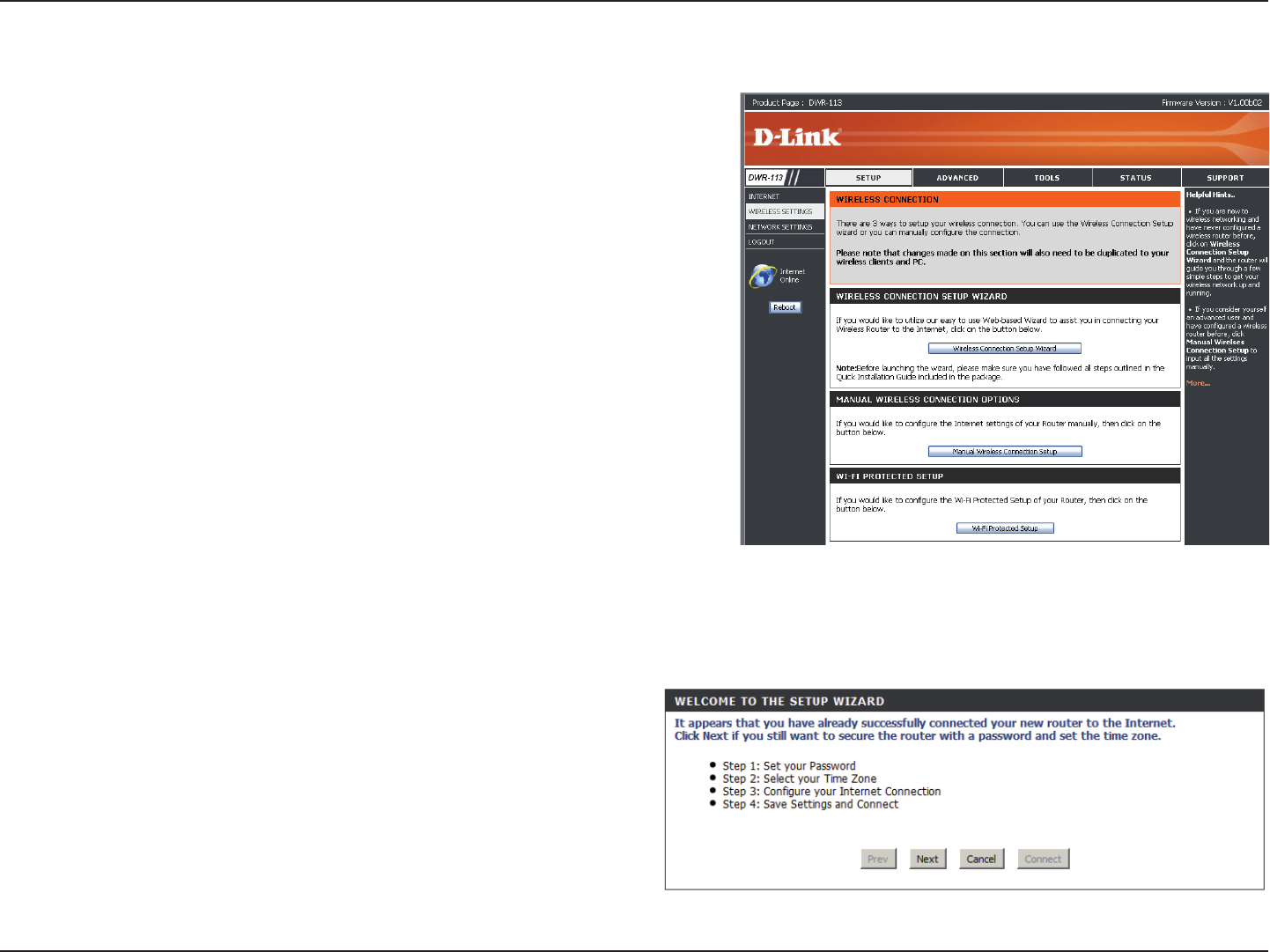
8D-Link DWR-113 User Manual
Section 3 - Configuration
Setup Wizard
The setup wizard guides you through the initial setup of your router.
There are two ways to setup your Internet connection. You can use the
Web-based Internet Connection Setup Wizard or you can manually
congure using the Manual Internet Connection Setup wizard.
Click Internet Connection Setup Wizard to begin.
If you want to enter your settings without running the wizard, click
Manual Internet Connection Setup and skip to page 13.
This wizard will guide you through a step-by-step process to congure
your D-Link router to connect to the Internet.
Click Next to continue.
Internet Connection Setup Wizard
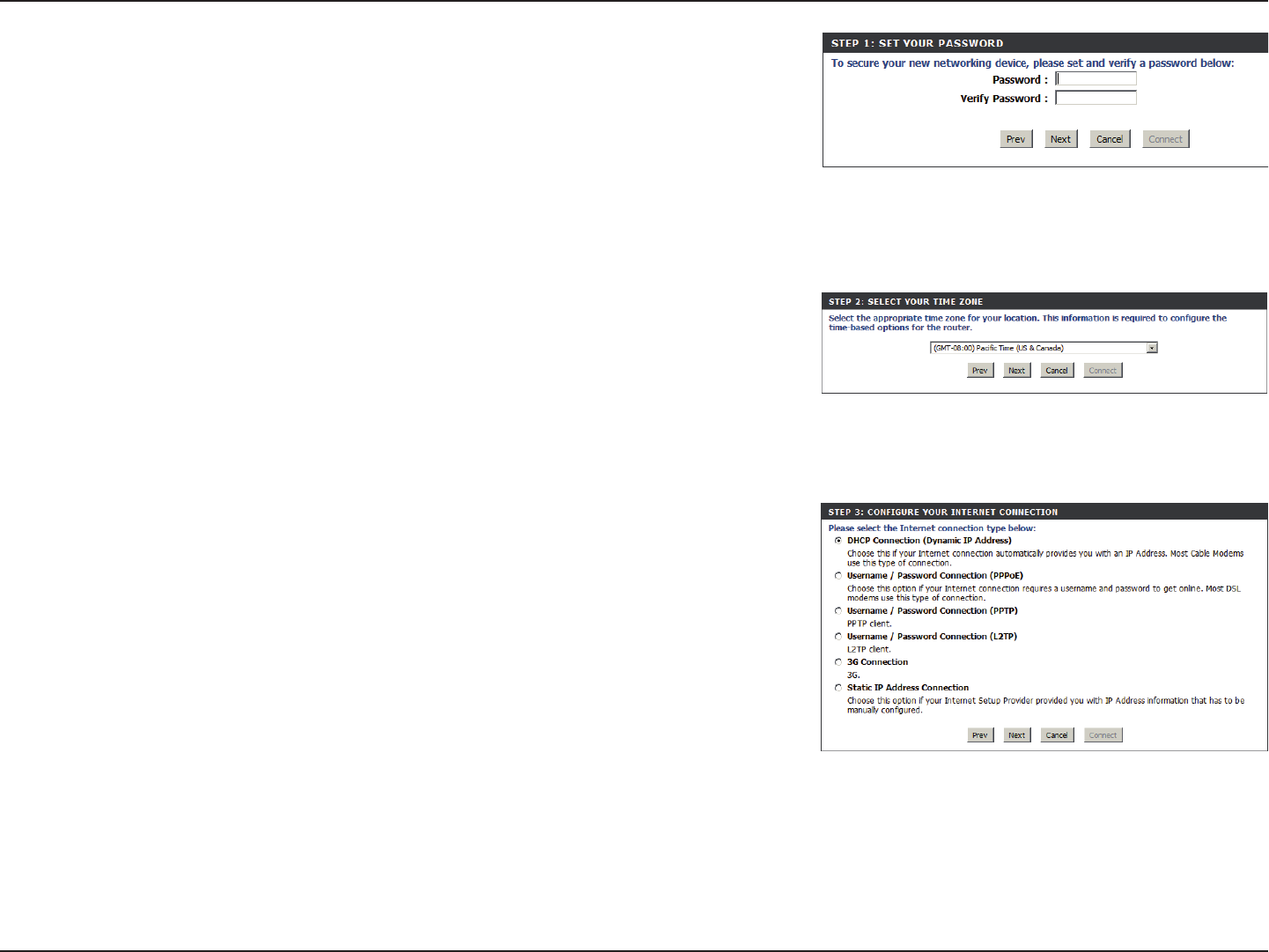
9D-Link DWR-113 User Manual
Section 3 - Configuration
Create a new password and then click Next to continue.
Click Prev to go back to the previous page or click Cancel to close the wizard.
Select your time zone from the drop-down box and then click Next to continue.
Click Prev to go back to the previous page or click Cancel to close the wizard.
Select the Internet connection type. The connection types are explained on the
following page. If you are unsure of the correct connection type, you may have to
contact your Internet Service Provider (ISP).
Click Prev to go back to the previous page or click Cancel to close the wizard.
Note: The DWR-113 supports several kinds of WAN interfaces, allowing you to
assign either a WAN or a WWAN(3G) connection as the Backup WAN. If the Primary
WAN is down or unavailable, congure the Backup WAN to Enable, and all the trafc
will be routed through Backup WAN. This feature is called WAN Failover. You can
use WAN Failover if you need redundancy to your Internet connection or any other
network.

10D-Link DWR-113 User Manual
Section 3 - Configuration
Choose this if your Internet connection automatically provides you with an IP Address. Most cable modems
use this type of connection. See page 16 for information about how to congure this type of connection.
Choose this option if your Internet connection requires a username and password to connect. Most DSL modems
use this style of connection. See page 17 for information about how to congure this type of connection.
Choose this option if your Internet connection requires Point-to-Point Tunneling Protocol (PPTP). See page
18 for information about how to congure this type of connection.
Choose this option if your Internet connection requires Layer 2 Tunneling Protocol (L2TP). See page 19 for
information about how to congure this type of connection.
Choose this option if your Internet Setup Provider provided you with IP Address information that has to be
manually congured. See page 21 for information about how to congure this type of connection.
DHCP Connection
(Dynamic IP Address):
Username / Password
Connection (PPPoE):
Username / Password
Connection (PPTP):
Username / Password
Connection (L2TP):
Static IP Address
Connection:
The subsequent conguration pages will differ depending on the selection you make on this page.
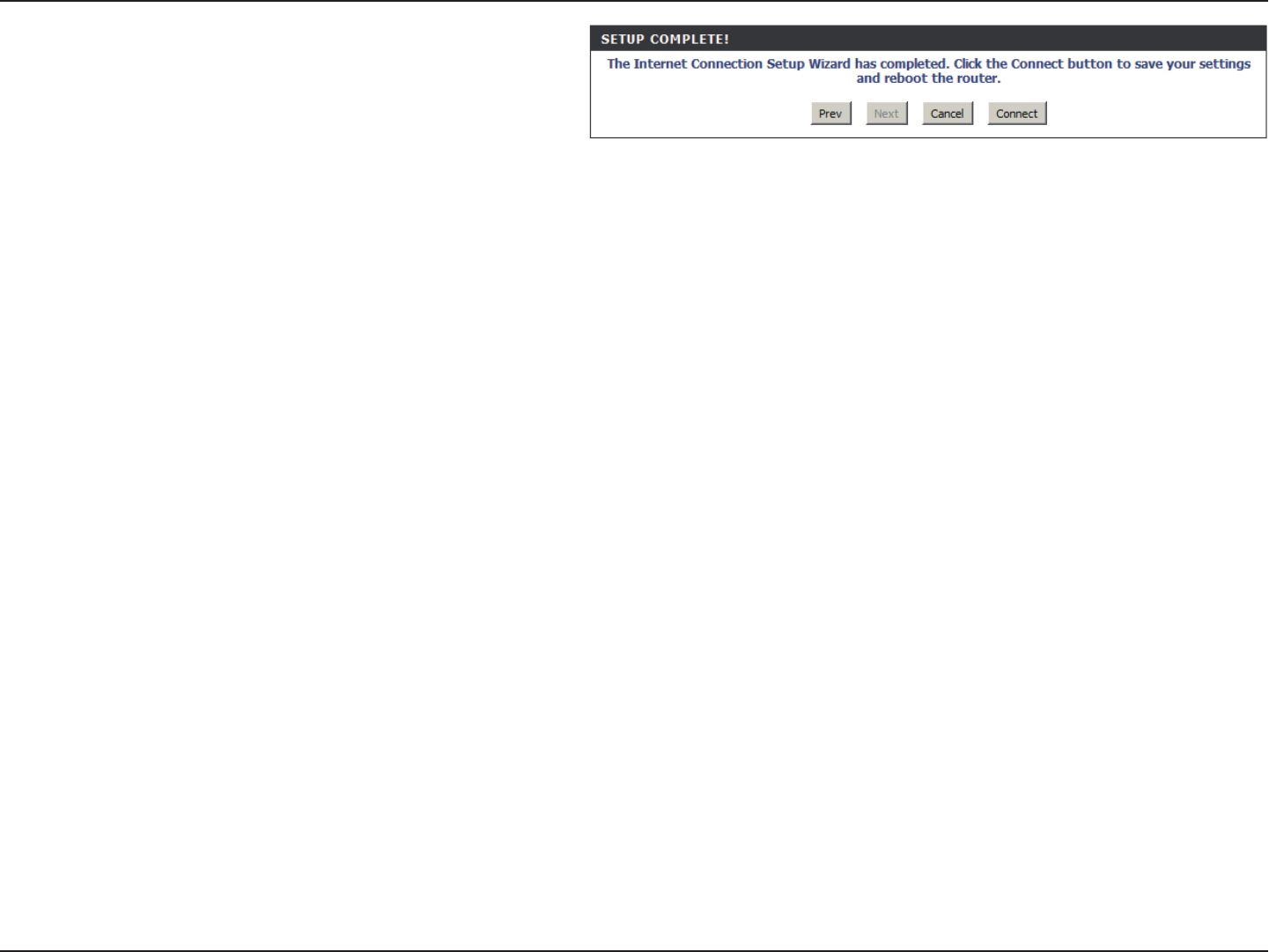
11D-Link DWR-113 User Manual
Section 3 - Configuration
You have completed the Setup Wizard.
Click Connect to save your settings.
A popup will appear, to conrm your settings.
Click OK to save your settings.
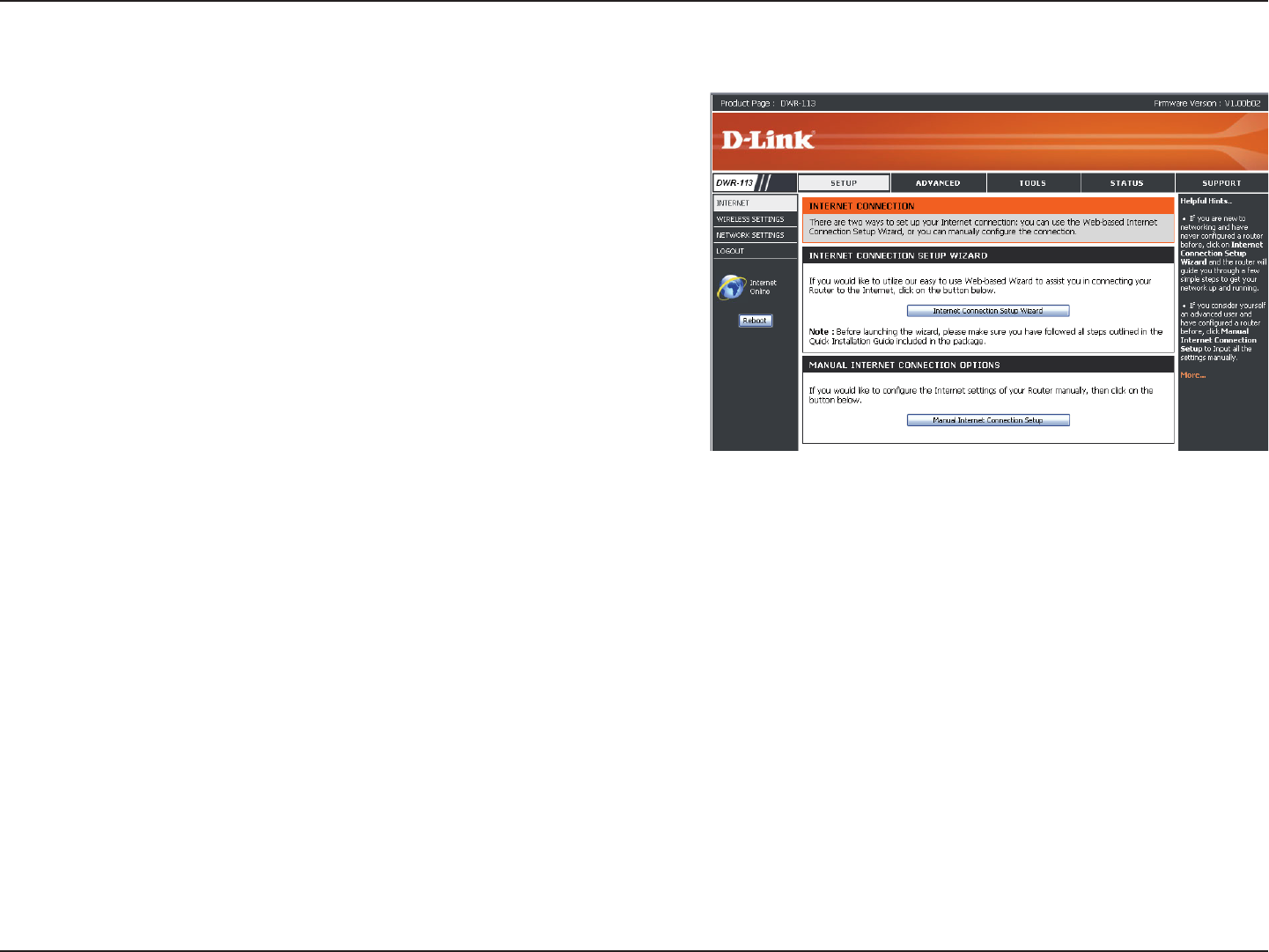
12D-Link DWR-113 User Manual
Section 3 - Configuration
Manual Internet Connection Setup
Click Manual Internet Connection Setup to begin.
If you want to congure your router to connect to the Internet using the
wizard, click Internet Connection Setup Wizard and refer to page 9.
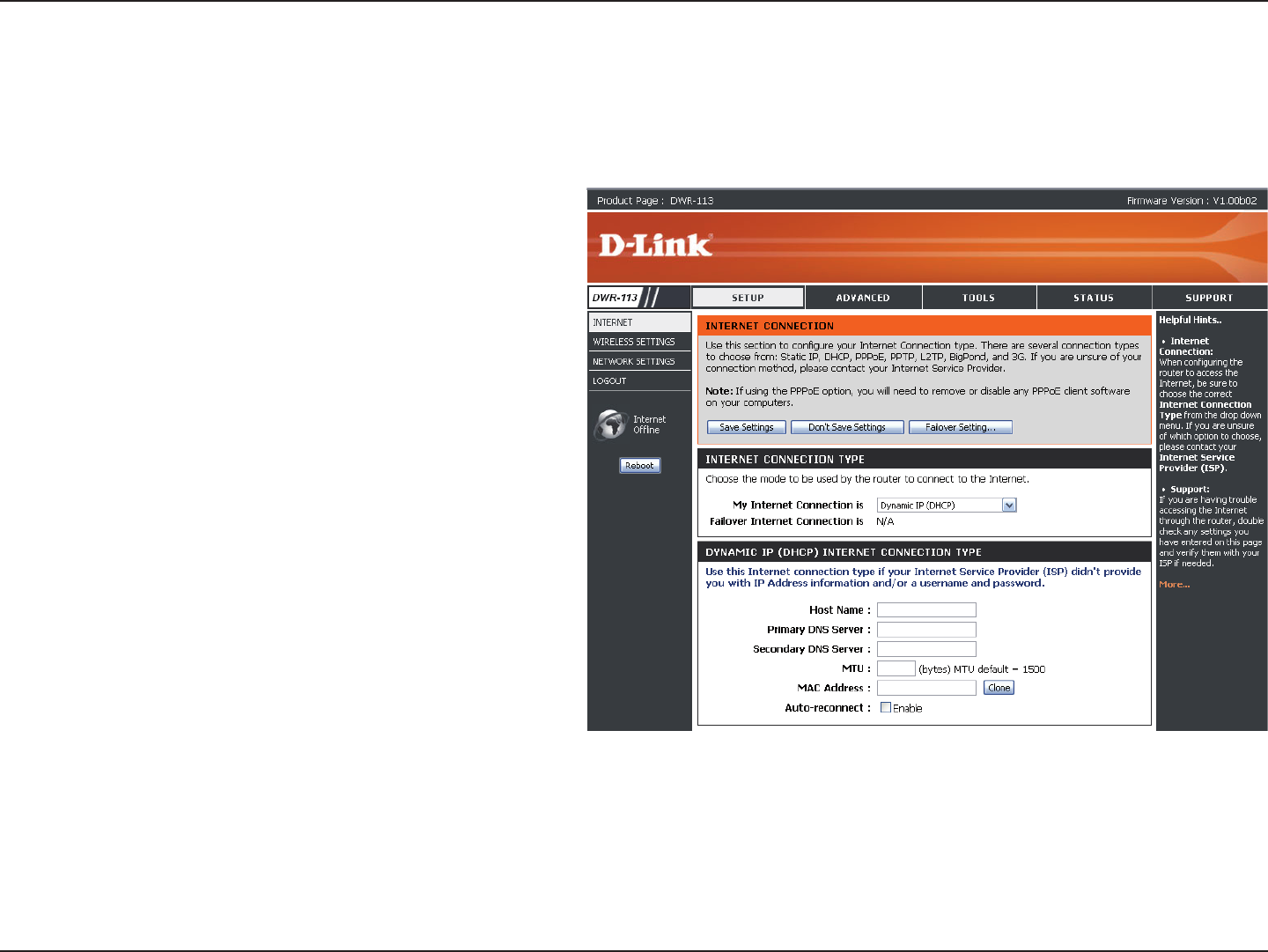
13D-Link DWR-113 User Manual
Section 3 - Configuration
Several different Internet Connection types can be selected depending upon the specications of your Internet Service Provider (ISP).
Select the Internet Connection type
specied by your Internet Service
Provider (ISP). The corresponding
settings will be displayed below.
Please see the following pages for
details on how to congure these
different connection types.
This connection can serve as a
backup for your default connection.
Enter the name of the Internet
host to be used as the backup
connection.
Enter the primary DNS server.
Enter the secondary DNS server.
Set the MTU (the default value is
1500).
Manually enter the MAC address or
click Clone to copy the PC’s MAC
address.
Tick this check box to enable auto-
reconnect.
Internet Connection
Internet Connection Type
My Internet Connection is:
Failover Internet
Connection is:
Host Name:
Primary DNS Server:
Secondary DNS Server:
MTU:
MAC Address:
Auto-reconnect:
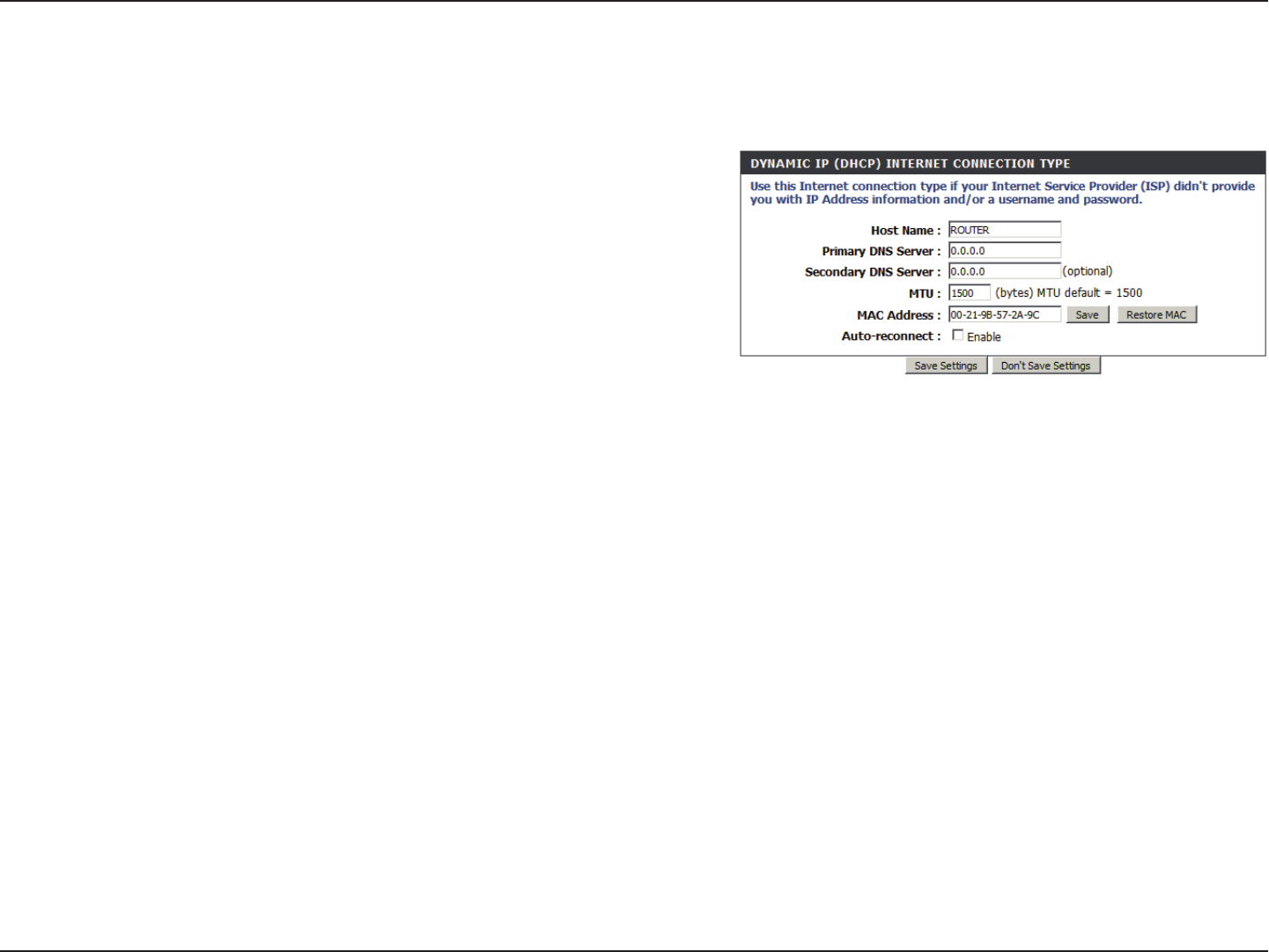
14D-Link DWR-113 User Manual
Section 3 - Configuration
Dynamic IP (DHCP)
(Optional) Required by some ISPs.
(Optional) Fill in with IP address of primary DNS
server.
(Optional) Fill in with IP address of secondary DNS
server.
You may need to change the Maximum Transmission
Unit (MTU) for optimal performance. The default
value is 1500.
The default MAC Address is set to the Internet port’s physical interface MAC address on the Broadband Router.
It is not recommended that you change the default MAC address unless required by your ISP. You can use
the Clone Your PC’s MAC Address button to replace the Internet port’s MAC address with the MAC address
of your PC.
This feature enables this product to renew WAN IP address automatically when the lease time is expiring.
Click Save Settings to save your changes, or click Don’t Save Settings to discard your changes.
This section will help you to obtain IP Address information automatically from your ISP. Use this option if your ISP didn’t provide you with
IP Address information and/or a username and password.
Host Name:
Primary DNS Server:
Secondary DNS Server:
MTU (Maximum
Transmission Unit):
MAC Address:
Auto-reconnect:
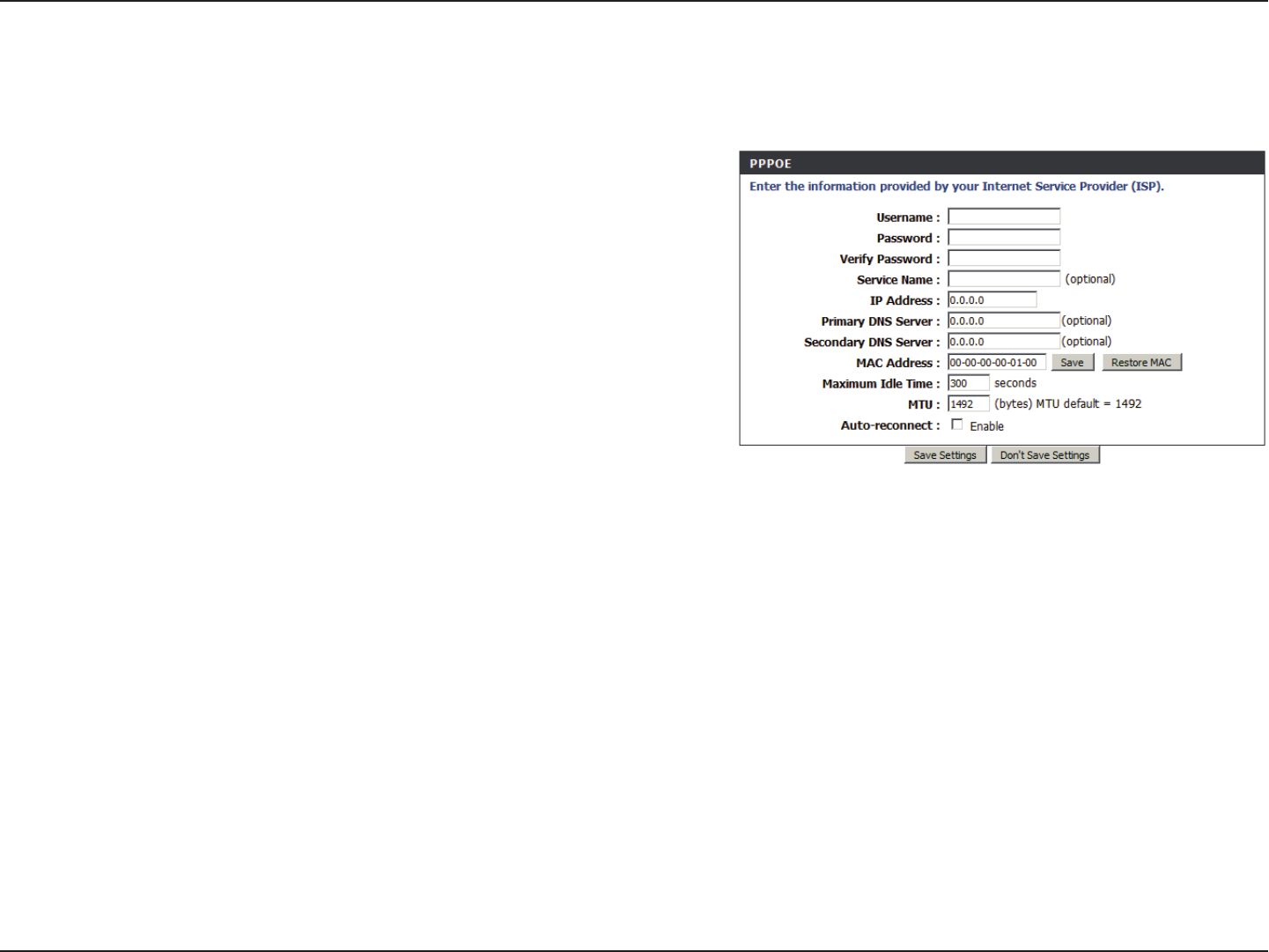
15D-Link DWR-113 User Manual
Section 3 - Configuration
PPPoE
Choose this Internet connection if your ISP provides you PPPoE account.
The username/account name that your ISP provides
to you for PPPoE dial-up.
Password that your ISP provides to you for PPPoE
dial-up.
Fill in with the same password in Password eld.
(Optional) Fill in if provided by your ISP.
(Optional) Fill in if provided by your ISP. If not, keep
the default value.
(Optional) Fill in if provided by your ISP. If not, keep
the default value.
(Optional) Fill in if provided by your ISP. If not, keep the default value.
MAC address of WAN interface. You can also copy MAC address of your PC to its WAN interface by pressing
Clone Your PC’s MAC button. The Restore MAC button will reset the router to its default MAC address.
The amount of time of inactivity before disconnecting established PPPoE session. Set it to zero or enable
Auto-reconnect will disable this feature.
The default setting of PPPoE is 1492.
The device will dial-up PPPoE connection automatically.
Click Save Settings to save your changes, or click Don’t Save Settings to discard your changes.
Username:
Password:
Verify Password:
Service Name:
IP Address:
Primary DNS Server:
Secondary DNS Server:
MAC Address:
Maximum Idle Time:
Maximum Transmission
Unit (MTU):
Auto-reconnect:

16D-Link DWR-113 User Manual
Section 3 - Configuration
PPTP
Choose this Internet connection if your ISP provides you PPTP account.
Choose Static IP only if your ISP assigns you an IP
address. Otherwise, please choose Dynamic IP.
Enter the information provided by your ISP.
(Only applicable for Static IP PPTP.)
Enter the information provided by your ISP.
(Only applicable for Static IP PPTP.)
Enter the information provided by your ISP.
(Only applicable for Static IP PPTP.)
IP address of PPTP server.
User/account name that your ISP provides to you for PPTP dial-up.
Password that your ISP provides to you for PPTP dial-up.
Fill in with the same password in Password eld.
Choose Always-on when you want to establish PPTP connection all the time. If you choose Connect-on-
demand, the device will establish PPTP connection when local users want to surf Internet, and disconnect if
no trafc after time period of Maximum Idle Time.
The time of no activity to disconnect your PPTP session. Set it to zero or choose Always-on to disable this
feature.
Click Save Settings to save your changes, or click Don’t Save Settings to discard your changes.
Address Mode:
PPTP IP Address:
PPTP Subnet Mask:
PPTP Gateway IP Address:
PPTP Server IP Address:
Username:
Password:
Verify Password:
Reconnect Mode:
Maximum Idle Time:
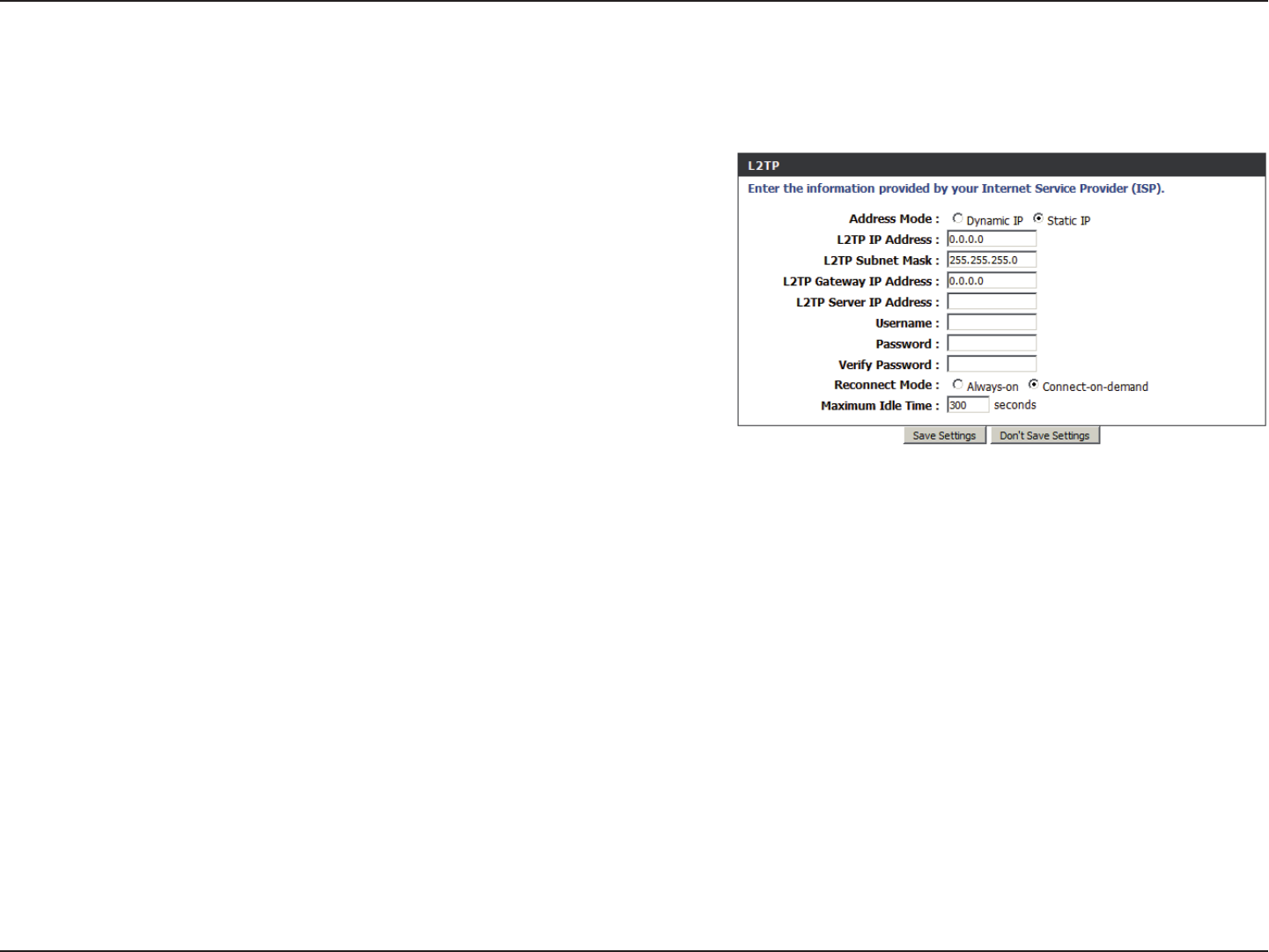
17D-Link DWR-113 User Manual
Section 3 - Configuration
L2TP
Choose this Internet connection if your ISP provides you L2TP account.
Choose Static IP only if your ISP assigns you an IP
address. Otherwise, please choose Dynamic IP.
Enter the information provided by your ISP.
(Only applicable for Static IP L2TP.)
Enter the information provided by your ISP.
(Only applicable for Static IP L2TP.)
Enter the information provided by your ISP.
(Only applicable for Static IP L2TP.)
IP address of L2TP server.
User/account name that your ISP provides to you for L2TP dial-up.
Password that your ISP provides to you for L2TP dial-up.
Fill in with the same password in Password eld.
Choose Always-on when you want to establish L2TP connection all the time. Choose Connect-on-demand the
device will establish L2TP connection when local users want to surf Internet, and disconnect if no trafc after
time period of Maximum Idle Time.
The time of no activity to disconnect your L2TP session. Set it to zero or choose Always-on to disable this
feature.
Click Save Settings to save your changes, or click Don’t Save Settings to discard your changes.
Address Mode:
L2TP IP Address:
L2TP Subnet Mask:
L2TP Gateway IP Address:
L2TP Server IP Address:
Username:
Password:
Verify Password:
Reconnect Mode:
Maximum Idle Time:

18D-Link DWR-113 User Manual
Section 3 - Configuration
Fill in a name to indicate the following 3G
conguration.
(Optional) Fill in only if requested by ISP.
(Optional) Fill in only if requested by ISP.
Enter the number to be dialed.
PAP, CHAP, or Auto detection. The default
authentication method is Auto.
(Optional) Enter the APN information.
Enter the PIN associated with your SIM card.
Auto or Manual. Connect to 3G network automatically or manually.
The time of no activity to disconnect established 3G session. Set it to zero or choose Auto in Reconnect Mode
to disable this feature.
(Optional) Fill in if provided by your ISP. If not, keep the default value.
(Optional) Fill in if provided by your ISP. If not, keep the default value.
Disable or Use LCP Echo Request. It depends on ISP requirement.
Activate this feature to change Ethernet WAN port to LAN port.
Click Save Settings to save your changes, or click Don’t Save Settings to discard your changes.
Account/Profile Name:
Username:
Password:
Dialed Number:
Authentication:
APN:
PIN:
Reconnect Mode:
Maximum Idle Time:
Primary DNS Server:
Secondary DNS Server:
Keep Alive:
Bridge Ethernet Ports:
3G
Choose this Internet connection if you already use a SIM card for 3G Internet service from your Telecom company. The elds here may
not be necessary for your connection. The information on this page should only be used if required by your service provider.
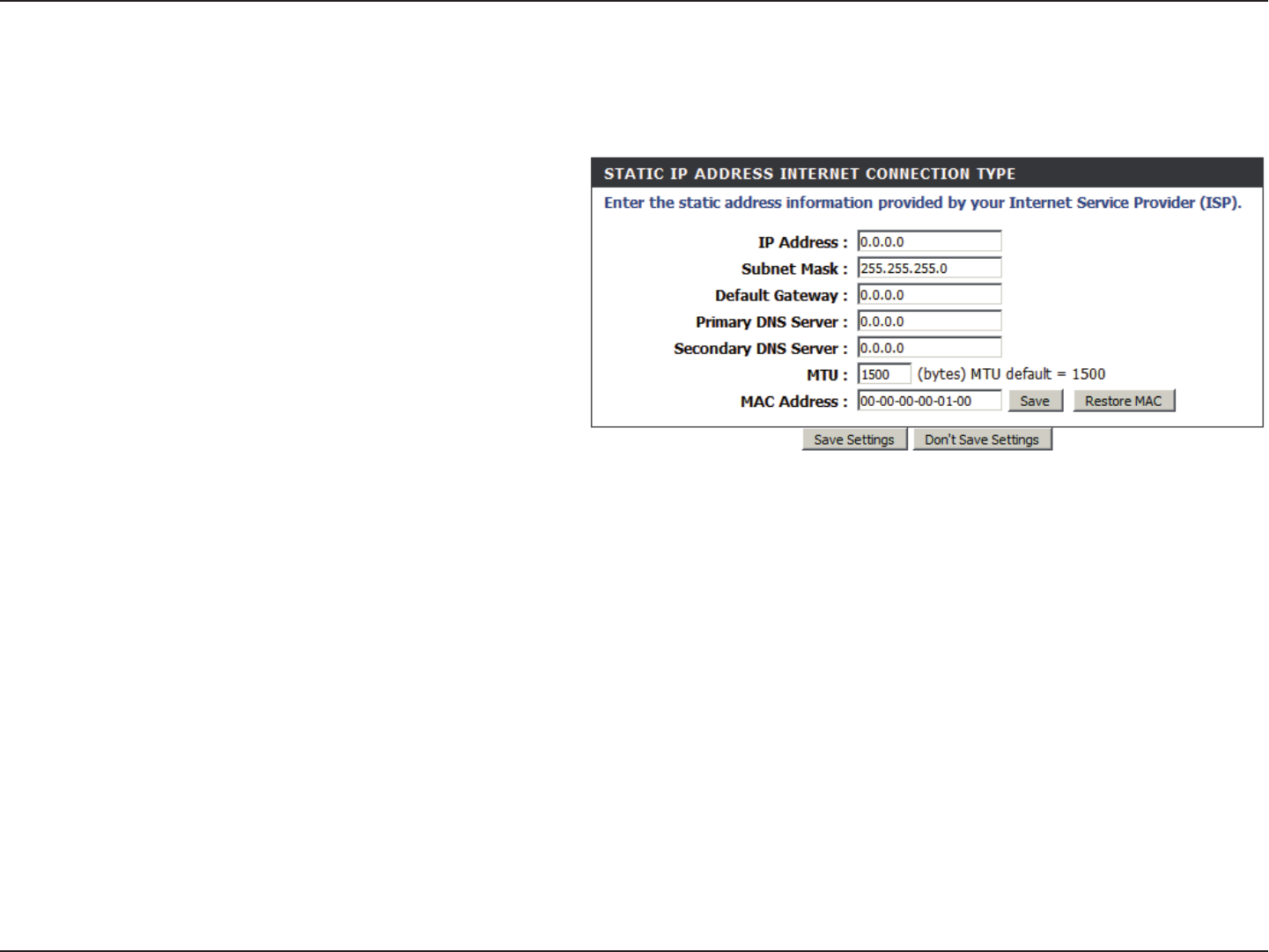
19D-Link DWR-113 User Manual
Section 3 - Configuration
Enter the IP address assigned to
your network connection.
Enter the subnet mask.
Enter the default gateway.
Enter the primary DNS server.
Enter the secondary DNS server.
You may need to change the
Maximum Transmission Unit (MTU)
for optimal performance. The default value is 1500.
The default MAC Address is set to the Internet port’s physical interface MAC address on the Broadband Router.
It is not recommended that you change the default MAC address unless required by your ISP. You can use
the Clone Your PC’s MAC Address button to replace the Internet port’s MAC address with the MAC address
of your Ethernet card.
Click Save Settings to save your changes, or click Don’t Save Settings to discard your changes.
IP Address:
Subnet Mask:
Default Gateway:
Primary DNS Server:
Secondary DNS Server:
MTU:
MAC Address:
Choose this Internet connection if your ISP assigns you a static IP address.
Static IP
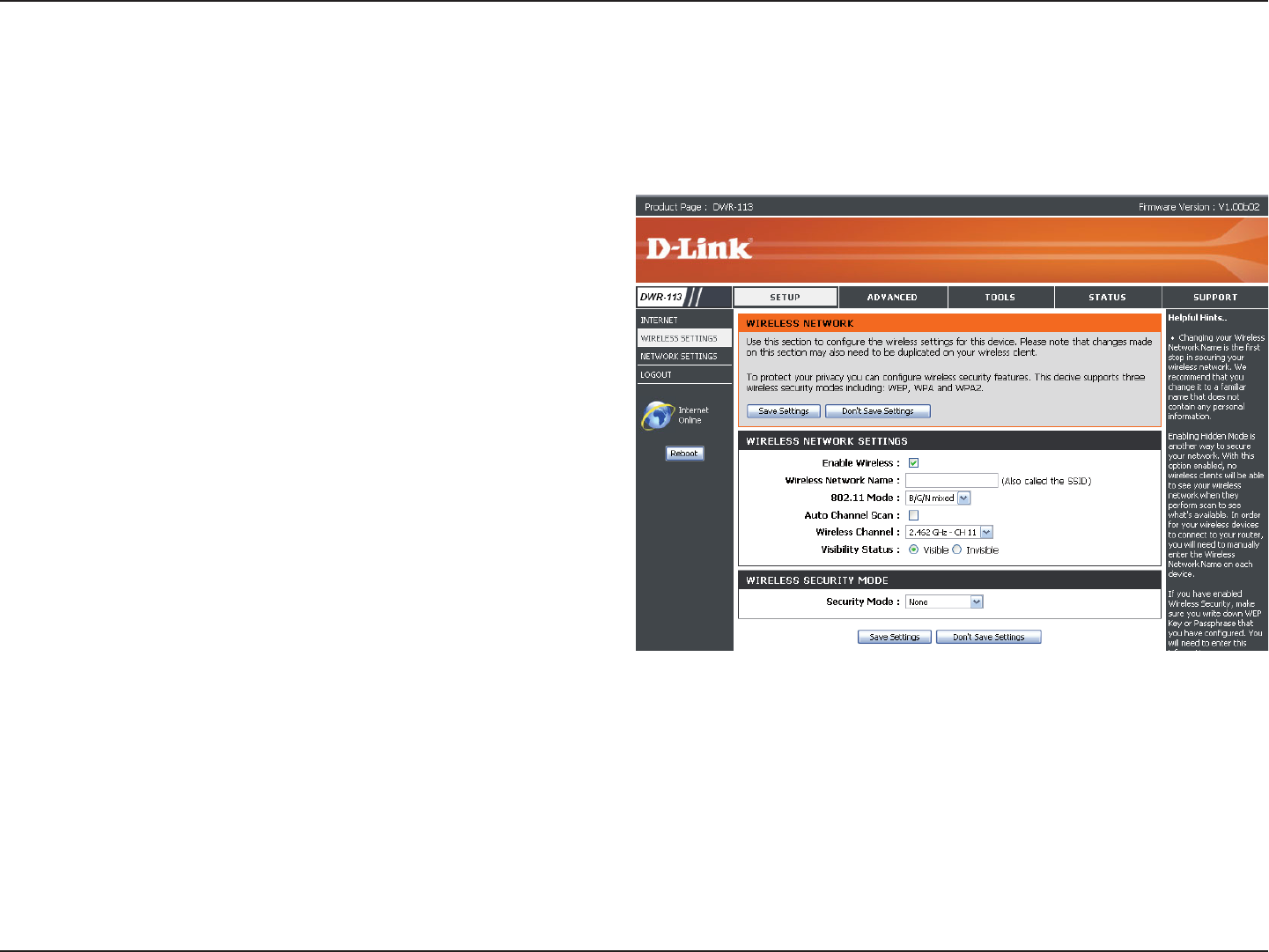
20D-Link DWR-113 User Manual
Section 3 - Configuration
Select this checkbox to enable wireless
access. When you set this option, the
following parameters take effect.
Also known as the SSID (Service
Set Identifier), this is the name of
your Wireless Local Area Network
(WLAN). Enter a name using up to 32
alphanumeric characters. The SSID
is case-sensitive. The default name is
“dlink_DWR-113”.
B/G/N mixed: Enable this mode if your
network contains a mix of 802.11b and
802.11g devices.
G mode: Enable this mode if your
network has only 802.11g devices. If you
have both 802.11b and 802.11g wireless
clients, disable this mode.
A wireless network uses specic channels in the wireless spectrum to handle communication between clients.
Some channels in your area may experience interference from other electronic devices. Choose the clearest
channel to help optimize the performance and coverage of your wireless network.
Click Save Settings to save your changes, or click Don’t Save Settings to discard your changes.
WIRELESS NETWORK SETTINGS
Enable Wireless:
Wireless Network Name:
802.11 Mode:
Auto Channel Scan:
Wireless Settings
This section will help you to manually congure the wireless settings of your router. Please note that changes made on this section may
also need to be duplicated on your Wireless Client.
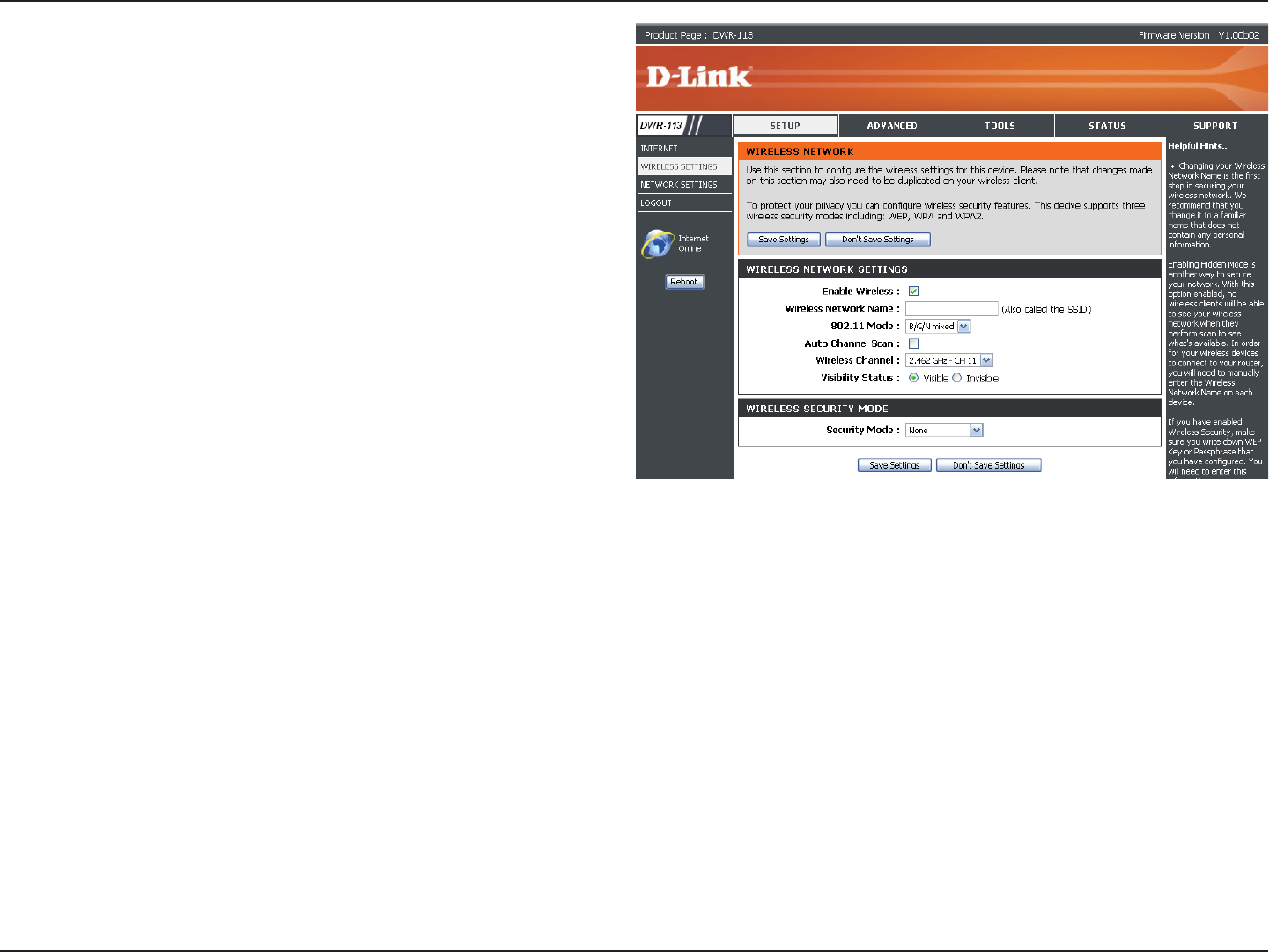
21D-Link DWR-113 User Manual
Section 3 - Configuration
Indicates the channel setting for the
DWR-113. By default the channel is set
to 11. This can be changed to t the
channel setting for an existing wireless
network or to customize your wireless
network. Click Auto Channel Scan
to automatically select the channel
that it will operate on. This option is
recommended because the router
will choose the channel with the least
amount of interference.
Select Invisible if you do not want the
SSID of your wireless network to be
broadcasted by DWR-113. The SSID
of your router will not be seen by Site
Survey utilities. Therefore while setting
up your wireless clients, you will have
to manually enter your SSID to connect
to the router.
WIRELESS SECURITY MODE
This device supports three wireless security modes, WEP, WPA-Personal, WPA-Enterprise or None. WEP
is the original wireless encryption standard. WPA provides a higher level of security and WPA-Personal
does not require an authentication server. When WPA enterprise is enabled, the router uses EAP (802.1x) to
authenticate clients via a remote RADIUS server.
Click Save Settings to save your changes, or click Don’t Save Settings to discard your changes.
Wireless Channel:
Visibility Status:
Security Mode:
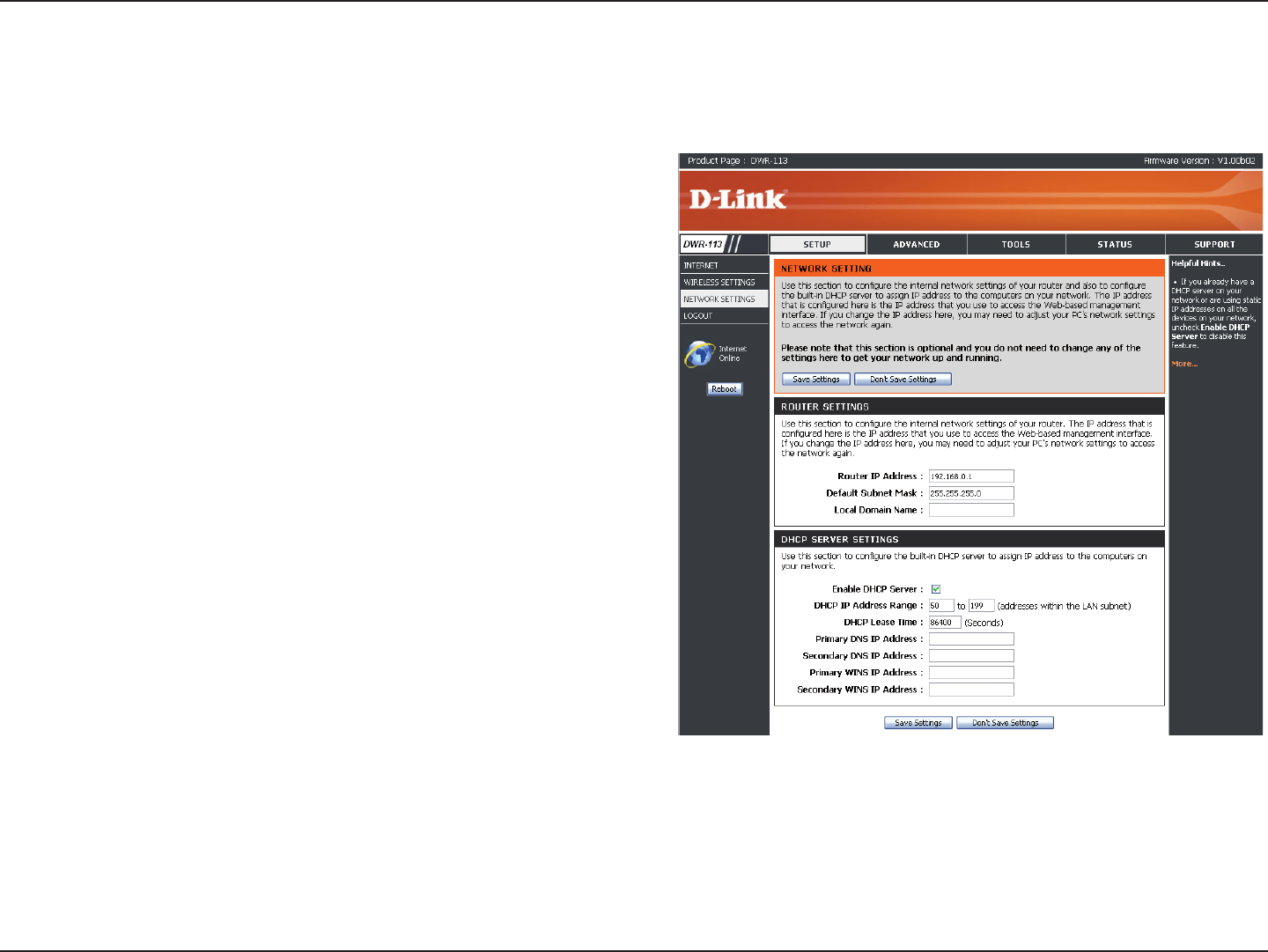
22D-Link DWR-113 User Manual
Section 3 - Configuration
This section will help you to change the internal network settings of your router and to congure the DHCP Server settings.
Network Settings
Router Settings
Enter the IP address of the router. The
default IP address is 192.168.0.1.
If you change the IP address, you will need
to enter the new IP address in your browser
to get into the conguration utility.
Enter the Subnet Mask of the router. The
default subnet mask is 255.255.255.0.
Enter the local domain name for your
network.
Click Save Settings to save your changes, or click Don’t Save Settings to discard your changes.
Router IP Address:
Default Subnet Mask:
Local Domain Name:

23D-Link DWR-113 User Manual
Section 3 - Configuration
Select this box to enable the DHCP
server on your router.
Enter the starting and ending
IP address for the server’s IP
assignment.
The time period for the IP address
lease. Enter the Lease time in
minutes.
Primary DNS IP Address: assign
a primary DNS Server to DHCP
clients.
Secondary DNS IP Address: assign a DNS Server to DHCP clients.
Primary WINS IP Address: assign a primary WINS Server to DHCP clients.
Secondary WINS IP Address: assign a WINS Server to DHCP clients.
Click Save Settings to save your changes, or click Don’t Save Settings to discard your changes.
Enable DHCP Server:
DHCP IP Address Range:
DHCP Lease Time:
Primary DNS IP Address:
Secondary DNS IP Address:
Primary WINS IP Address:
Secondary WINS IP
Address:
DHCP Server Settings
The DWR-113 has a built-in DHCP (Dynamic Host Control Protocol) server. The DHCP server assigns IP addresses to devices on the
network that request them. By default, the DHCP Server is enabled on the device. The DHCP address pool contains a range of IP addresses,
which is automatically assigned to the clients on the network.

24D-Link DWR-113 User Manual
Section 3 - Configuration
Virtual Server
The device can be congured as a virtual server so that users can access services such as Web or FTP via the public (WAN) IP address
of the router.
This contains a list of pre-defined
services.
Copies the rule to the line of the
specied ID.
You may select Always On or choose
the number of a schedule rule that you
have dened.
VIRTUAL SERVERS LIST
Identies the virtual server.
Enter the last digits of the IP address
of the computer on your local network
that you want to allow the incoming
service. In the next box, enter the port
number that you would like to open.
Select this box to enable the rule.
Specify the schedule rule number.
Click Save Settings to save your
changes, or click Don’t Save Settings
to discard your changes.
Well-known Services:
Copy to:
Use schedule rule:
ID:
Server IP: Port:
Enable:
Schedule Rule #:
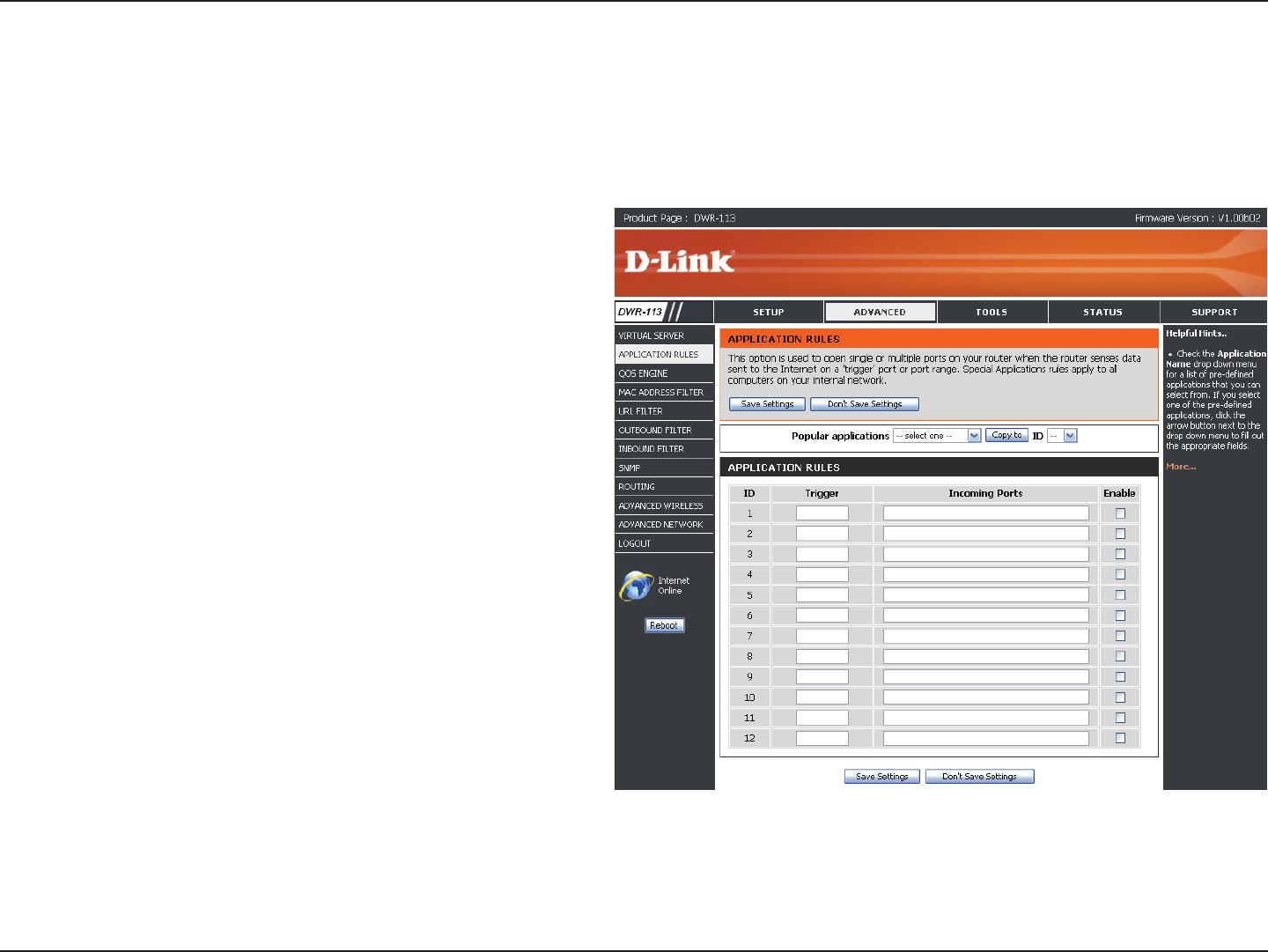
25D-Link DWR-113 User Manual
Section 3 - Configuration
Application Rules
Some applications require multiple connections, such as Internet gaming, video conferencing, Internet telephony and others. These
applications have difculties working through NAT (Network Address Translation). Applications Rules allow some of these applications
work with the DWR-113.
APPLICATION RULES
Select from a list of popular
applications.
Copies the predened application
rule to the line of the specied
ID.
Identies the rule.
The name of the trigger.
Specify the incoming port for the
trigger rule.
Select this box to enable the
rule.
Click Save Settings to save your changes, or click Don’t Save Settings to discard your changes.
Popular Applications:
Copy to ID:
ID:
Trigger:
Incoming Ports:
Enable:
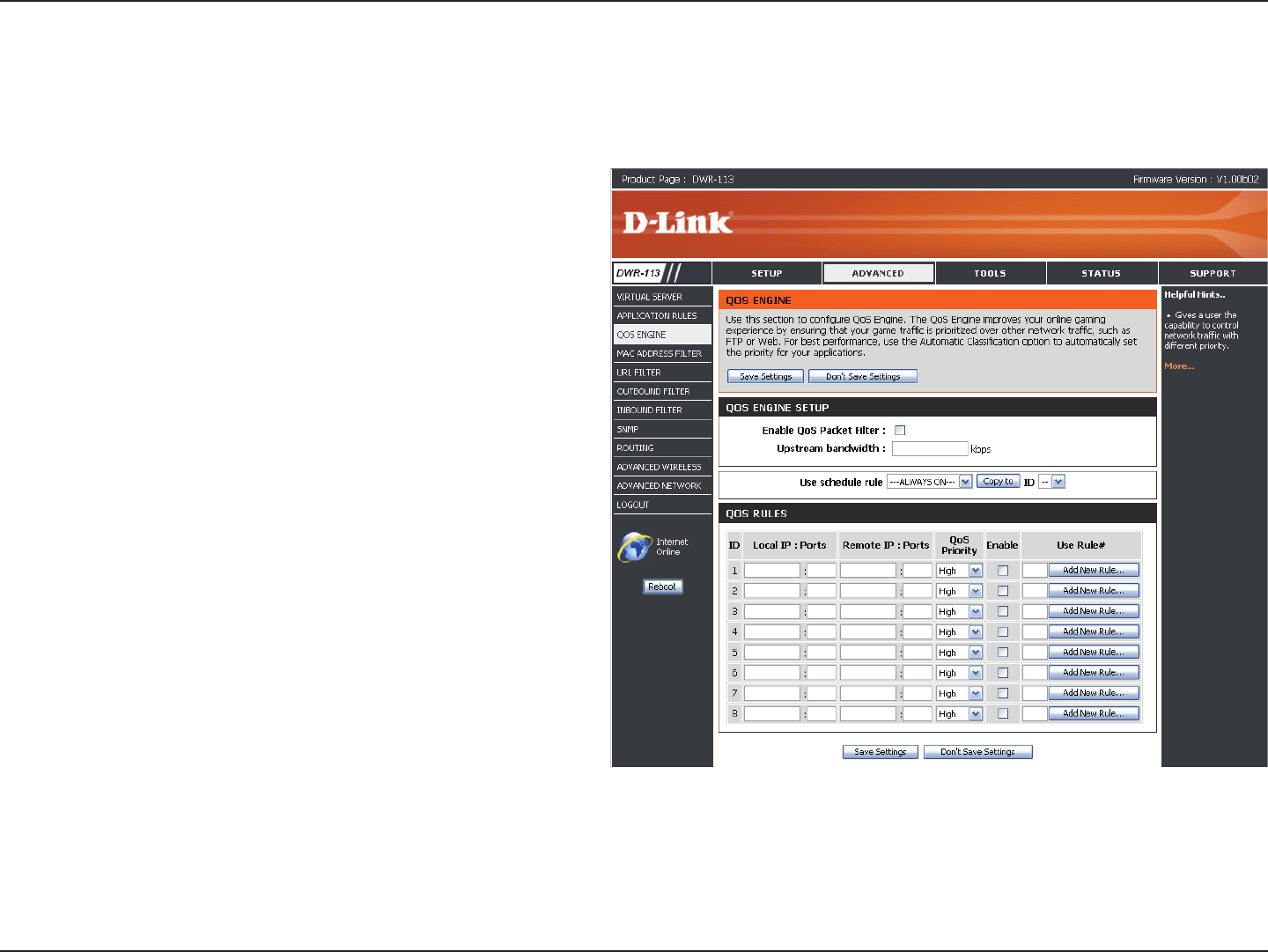
26D-Link DWR-113 User Manual
Section 3 - Configuration
QoS Engine
QoS ENGINE SETUP
Select this box to enable the QoS
Packet Filter.
Specify the maximum upstream
bandwidth here (e.g. 400 kbps).
QoS RULES
Identies the rule.
Specify the local IP address and
then specify the port after the colon.
Specify the remote IP address and
then the port after the colon.
Select Low, Normal, or High.
Select a checkbox to enable the
particular QoS rules individually.
Click Save Settings to save your
changes, or click Don’t Save Settings to discard your changes.
Enable QoS Packet Filter:
Upstream Bandwidth:
ID:
Local IP : Ports:
Remote IP : Ports:
QoS Priority:
Enable:
The QoS Engine improves your online gaming experience by ensuring that your game trafc is prioritized over other network trafc, such
as FTP or Web. For best performance, use the Automatic Classication option to automatically set the priority for the applications.
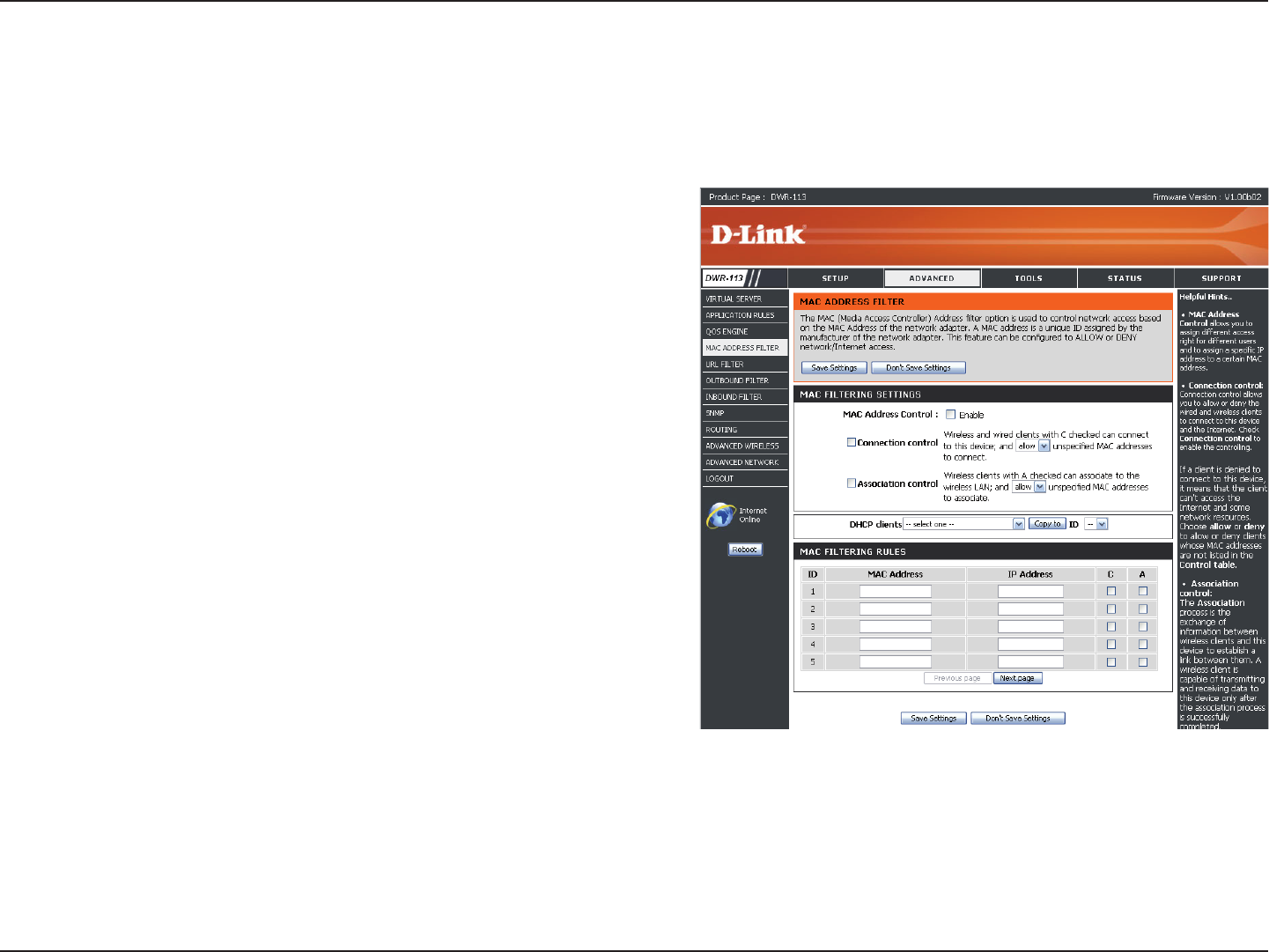
27D-Link DWR-113 User Manual
Section 3 - Configuration
MAC Address Filter
MAC FILTERING SETTINGS
Select this box to enable Mac Filtering.
Wireless and wired clients with C selected
can connect to this device and allow/deny
connections from unspecied MAC addresses.
Wireless clients with A selected can associate to
the wireless LAN; and allow/deny connections
from unspecied MAC addresses.
MAC FILTERING RULES
Identies the rule.
Specify the MAC Address of the computer to
be ltered.
Specify the last section of the IP address.
Click Trigger to congure Wake On LAN.
If this box is selected, the rule will follow the connection control setting specied in MAC ltering settings.
If this box is selected, the rule will follow the connection control setting specied in MAC ltering settings.
Click Save Settings to save your changes, or click Don’t Save Settings to discard your changes.
MAC Address Control:
Connection Control:
Association Control:
ID:
MAC Address:
IP Address:
Wake On LAN:
C:
A:
The MAC (Media Access Controller) Address Filter option is used to control network access based on the MAC Address of the network
adapter. A MAC address is a unique ID assigned by the manufacturer of the network adapter. This feature can be congured to ALLOW
or DENY network/Internet access.
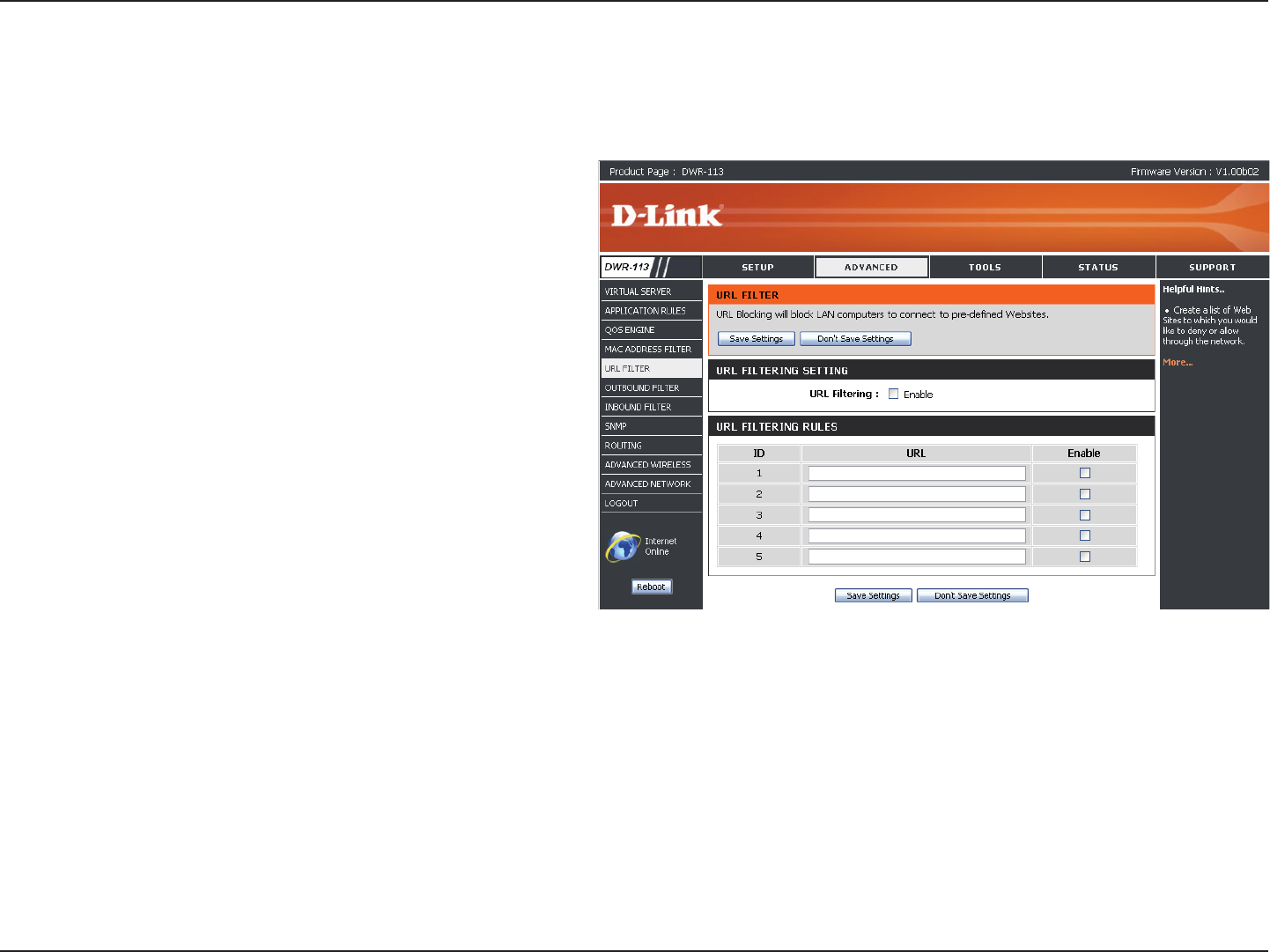
28D-Link DWR-113 User Manual
Section 3 - Configuration
Select this box to enable URL
Filtering.
URL FILTERING RULES
Identies the rule.
Enter URL that you would like to
block.
Click to enable the specic URL
lter.
URL Filter allows you to set up a list of Web-sites that will be blocked from users on your network.
URL Filter
Click Save Settings to save your changes, or click Don’t Save Settings to discard your changes.
URL Filtering:
ID:
URL:
Enable:

29D-Link DWR-113 User Manual
Section 3 - Configuration
OUTBOUND FILTER SETTING
Select this box to Enable the lter.
You may select Always On or
choose the number of a schedule
rule that you have dened.
Copies the predened lter to the
specied ID
OUTBOUND FILTER RULES LIST
Identies the lter.
Specify the local IP address and then
specify the port after the colon.
Specify the remote IP address and
then the port after the colon.
Select this box to enable the lter.
Specify the schedule rule number.
Go back to the previous lter page.
Advance to the next lter page.
Click Save Settings to save your changes, or click Don’t Save Settings to discard your changes.
Outbound Filter
Outbound Filter:
Use Schedule Rule:
Copy to ID:
ID:
Source IP : Ports:
Destination IP : Ports:
Enable:
Schedule Rule #:
Previous Page:
Next Page:
Outbound Filter enables you to control what packets are allowed to pass the router. Outbound lter applies on all outbound packets.
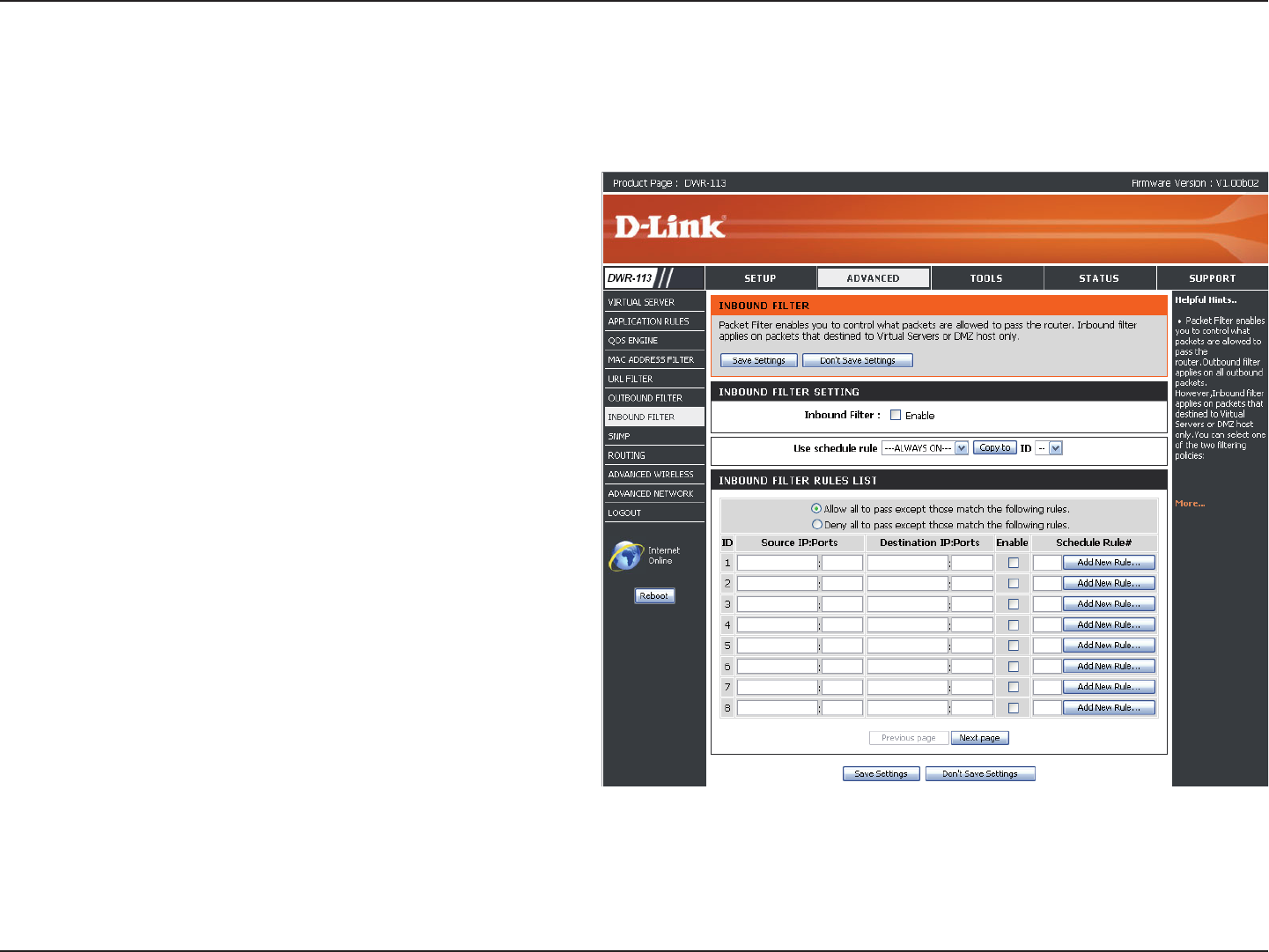
30D-Link DWR-113 User Manual
Section 3 - Configuration
INTBOUND FILTER SETTING
Select this box to Enable the lter.
You may select Always On or
choose the number of a schedule
rule that you have dened.
Copies the predened lter to the
specied ID
INBOUND FILTER RULES LIST
Identies the lter.
Specify the local IP address and then
specify the port after the colon.
Specify the remote IP address and
then the port after the colon.
Select this box to enable the lter.
Specify the schedule rule number.
Go back to the previous lter page.
Advance to the next lter page.
Click Save Settings to save your changes, or click Don’t Save Settings to discard your changes.
Inbound Filter
Inbound Filter:
Use Schedule Rule:
Copy to ID:
ID:
Source IP : Ports:
Destination IP : Ports:
Enable:
Schedule Rule #:
Previous Page:
Next Page:
Inbound Filter enables you to control what packets are allowed to pass the router. Inbound lter only applies to packets that are destined
for Virtual Servers or DMZ hosts.

31D-Link DWR-113 User Manual
Section 3 - Configuration
SNMP
Select Enabled to allow local SNMP
administration. Select Disabled to
disallow local SNMP administration.
Select Enabled to allow local SNMP
administration. Select Disabled to
disallow local SNMP administration.
Enter the password public in this
eld to allow “Read only” access to
network administration using SNMP.
You can view the network, but no
conguration is possible with this
setting.
Enter the password private in this
eld to gain “Read and Write” access
to the network using SNMP software.
Enter up to four IP addresses of any trap targets on your network.
Select the SNMP version of your system.
Click Save Settings to save your changes, or click Don’t Save Settings to discard your changes.
SNMP
SNMP Local:
SNMP Remote:
Get Community:
Set Community:
IP 1, IP 2, IP 3, IP 4:
SNMP Version:
SNMP (Simple Network Management Protocol) is a widely used network monitoring and control protocol that reports activity on each
network device to the administrator of the network. SNMP can be used to monitor trafc and statistics of the DWR-113. The DWR-113
supports SNMP v1 or v2c.
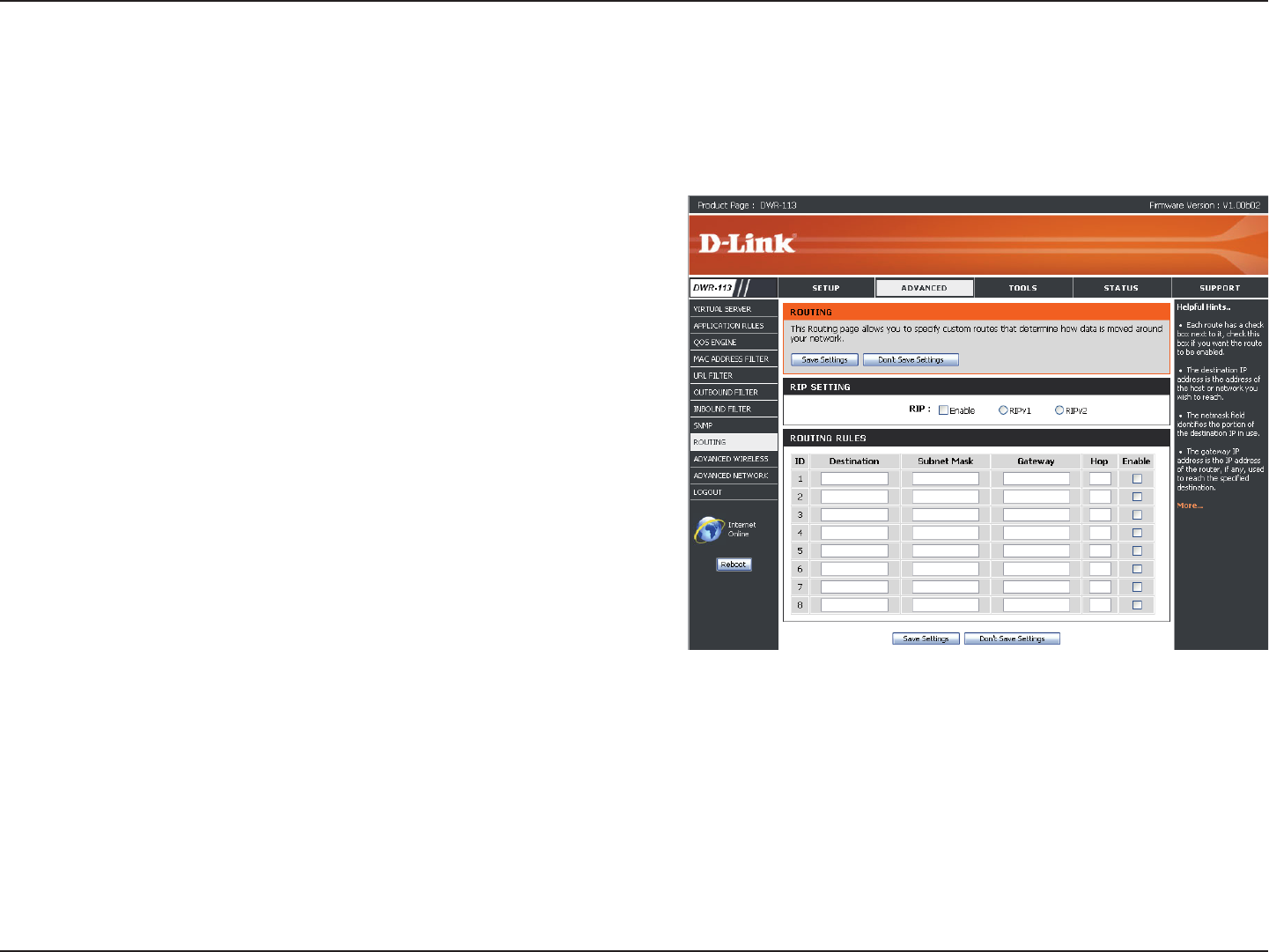
32D-Link DWR-113 User Manual
Section 3 - Configuration
RIP SETTING
Select this box to enable routing.
RIPv1: Protocol in which the IP address is
routed through the internet.
RIPv2: Enhanced version of RIPv1 with added
features such as Authentication, Routing
Domain, Next Hop Forwarding, and Subnet-
mask Exchange.
ROUTING RULES
Identies the rule.
Enter the IP of the specied network that you
want to access using the static route.
Enter the subnet mask to be used for the
specied net work.
Enter the gateway IP address to the specied network.
Enter the amount of hops it will take to reach the specied network.
Note: In a transmission path, each link is terminated at a network device such as a router or gateway. The
number of hops equals the number of routers or gateways that data must pass through before reaching the
destination.
Select this box to enable the rule.
Routing
RIP:
ID:
Destination:
Subnet Mask:
Gateway:
Hop:
Enable:
The Routing page allows you to specify custom routes that determine how data is moved around your network.
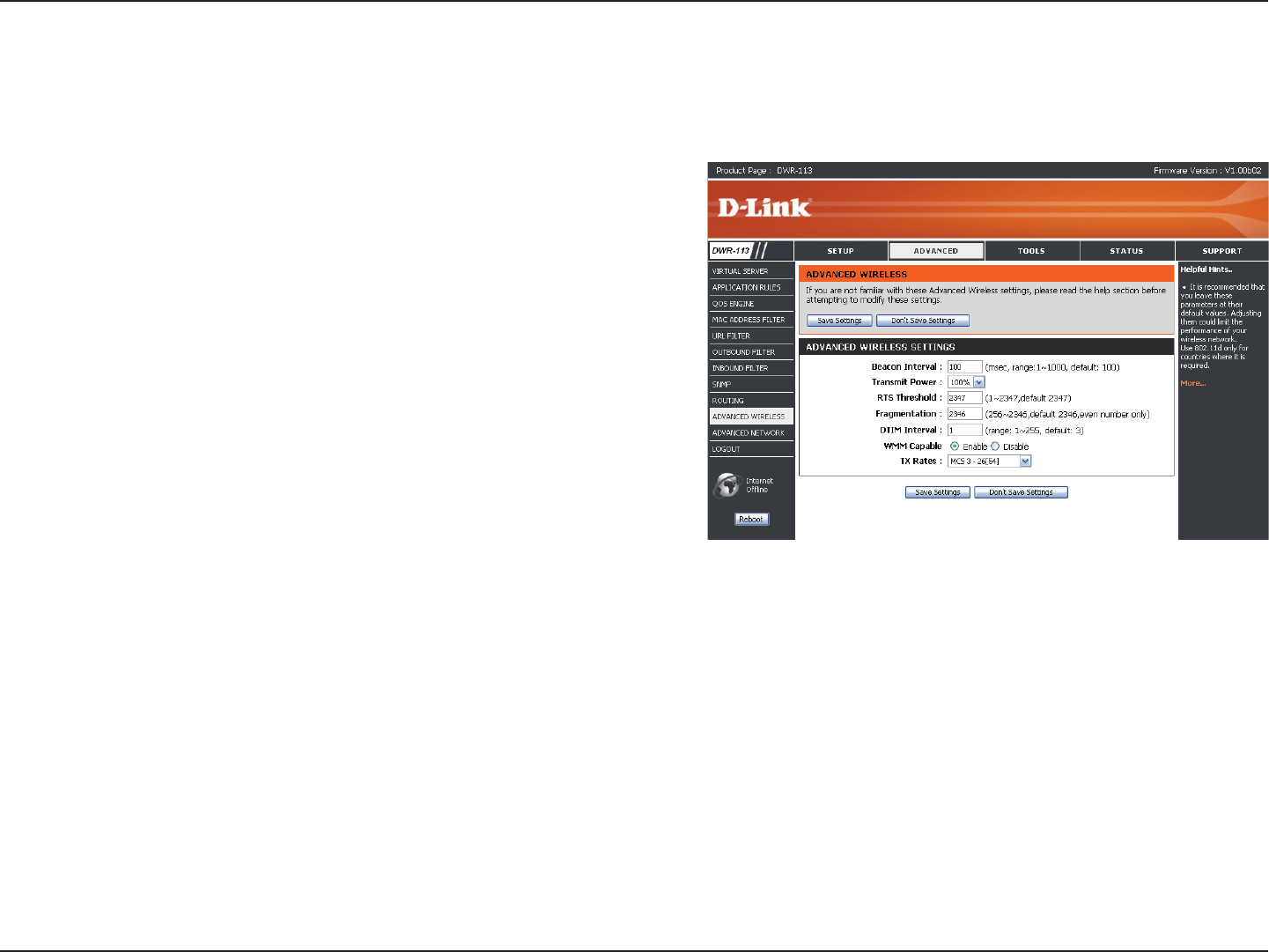
33D-Link DWR-113 User Manual
Section 3 - Configuration
Beacons are packets sent by an Access Point to
synchronize a wireless network. Specify a value.
100 is the default setting and is recommended.
Set the transmit power of the antennas.
This value should remain at its default setting of
2347. If inconsistent data ow is a problem, only
a minor modication should be made.
The fragmentation threshold, which is specied
in bytes, determines whether packets will be
fragmented. Packets exceeding the 2346 byte
setting will be fragmented before transmission.
2346 is the default setting.
A Delivery Trafc Indication Message (DTIM) is a countdown informing clients of the next window for listening
to broadcast and multicast messages. The default interval is 3.
WMM (Wi-Fi Multimedia) is QoS (Quality of Service) system for your wireless network. Enable this option to
improve the quality of video and voice applications for your wireless clients.
Select the basic transfer rates based on the speed of wireless adapters on your wireless network. It is strongly
recommended to keep this setting to Auto.
Click Save Settings to save your changes, or click Don’t Save Settings to discard your changes.
Beacon Interval:
Transmit Power:
RTS Threshold:
Fragmentation:
DTIM Interval:
WMM Capable:
TX Rates:
Advanced Wireless
Advanced Wireless contains settings which can negatively affect the performance of your router if congured improperly. Do not change
these settings unless you are already familiar with them or have been instructed to make the change by one of our support personnel.
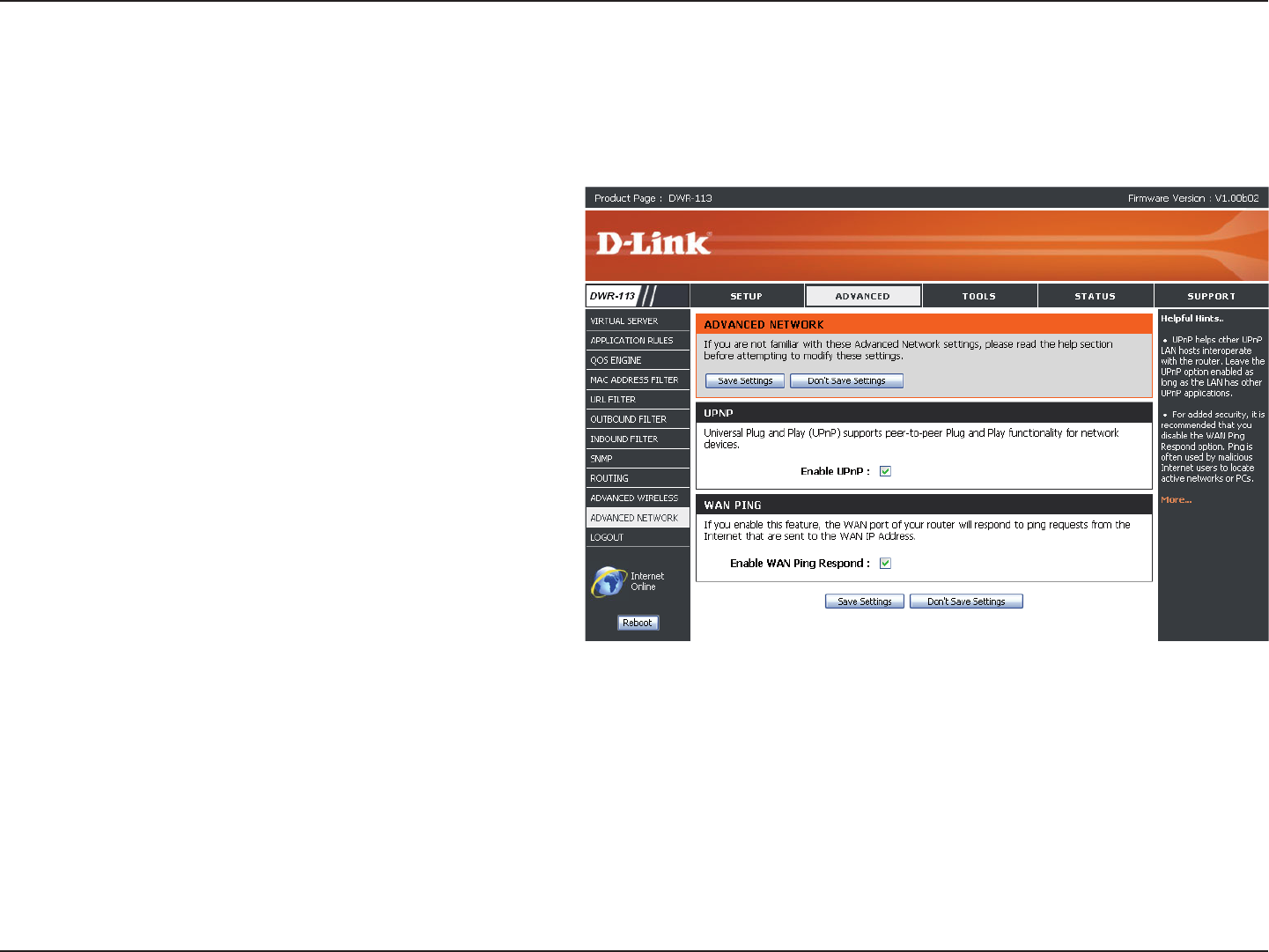
34D-Link DWR-113 User Manual
Section 3 - Configuration
UPnP
Click Enable UPnP to use
the Universal Plug and Play
(UPnP™) feature. UPnP provides
compatibility with networking
equipment, software and
peripherals.
WAN PING
Select the box to allow the WAN
port to be “pinged.” Blocking the
Ping option may provide some
extra security from hackers.
Click Save Settings to save your changes, or click Don’t Save Settings to discard your changes.
Advanced Network
Advanced Network contains settings which can change the way the router handles certain types of trafc. We recommend that you do
not change any of these settings unless you are already familiar with them or have been instructed to make the change by one of our
support personnel.
Enable UPnP:
Enable WAN Ping Respond:

35D-Link DWR-113 User Manual
Section 3 - Configuration
ADMINISTRATOR
Enter a password that the admin
account will use to access the
router’s management interface.
Conrm the chosen password.
REMOTE MANAGEMENT
Remote management allows the
DWR-113 to be configured from
the Internet using a web browser.
A username and password is
still required to access the Web-
Management interface. Usually
only a member of your network can
browse the built-in web pages to perform Administrator tasks. This feature enables you to perform Administrator
tasks from the remote (Internet) host.
Enter the Internet IP address of the PC that has access to the Broadband Router. If you enter an asterisk (*)
in this eld, then anyone will be able to access the Router. Adding an asterisk (*) into this eld could present
a security risk and is not recommended.
This is the port number used to access the router. Example: 8080 is the port used for the Web-Management
interface.
Click Save Settings to save your changes, or click Don’t Save Settings to discard your changes.
Admin
The Admin page allows you to change the Administrator password and enable Remote Management. The Admin has read/write access
while the user has read-only access. Only the admin has the ability to change both admin and user account passwords.
New Password:
Confirm Password:
Remote Management:
IP Allowed to Access:
Port:
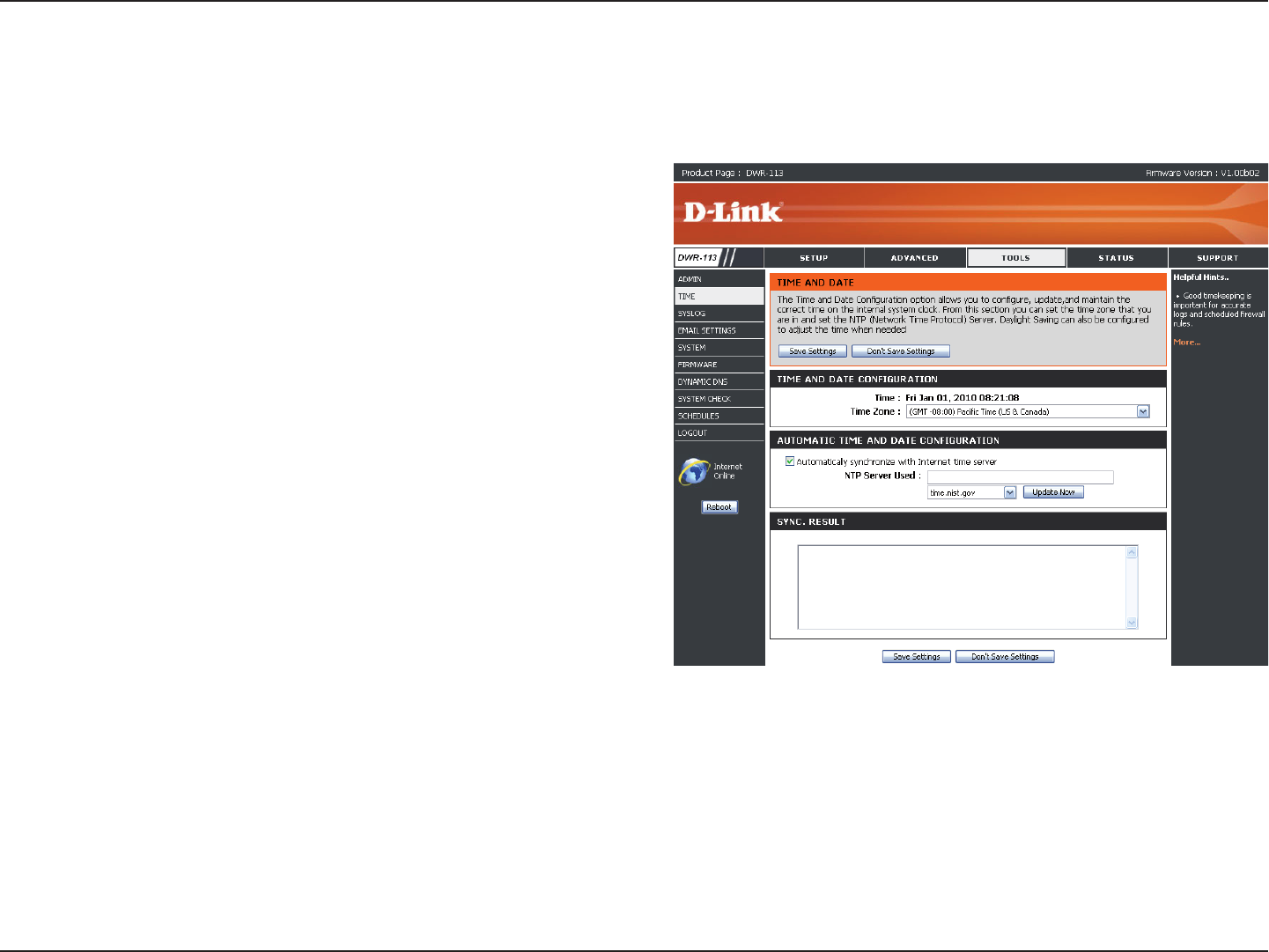
36D-Link DWR-113 User Manual
Section 3 - Configuration
Time
Displays the current time and date
of the DWR-113.
Select the appropriate Time Zone
from the drop-down box.
Select this checkbox to automatically
synchronize the DWR-113 with an
Internet time server.
Choose the NTP Server used for
synchronizing time and date.
Shows the result of the last time
synchronization.
This section will help you set the time zone that you are in and the NTP (Network Time Protocol) Server. Daylight Saving can also be
congured to adjust the time when needed.
Click Save Settings to save your changes, or click Don’t Save Settings to discard your changes.
Time:
Time Zone:
Automatically synchronize
with Internet time server:
NTP Server Used:
Sync. Result:

37D-Link DWR-113 User Manual
Section 3 - Configuration
Syslog
Select this box to send the router
logs to a Syslog Server.
Enter the address of the Syslog
server that will be used to send
the logs. You may also select
your computer from the drop-
down box (only if you want to
receive an IP address from the
router via DHCP).
The DWR-113 keeps a running log of events and activities occurring on the router. You may send these logs to a SysLog server on your
network.
Click Save Settings to save your changes, or click Don’t Save Settings to discard your changes.
Enable Logging to Syslog
Server:
Syslog Server IP Address:
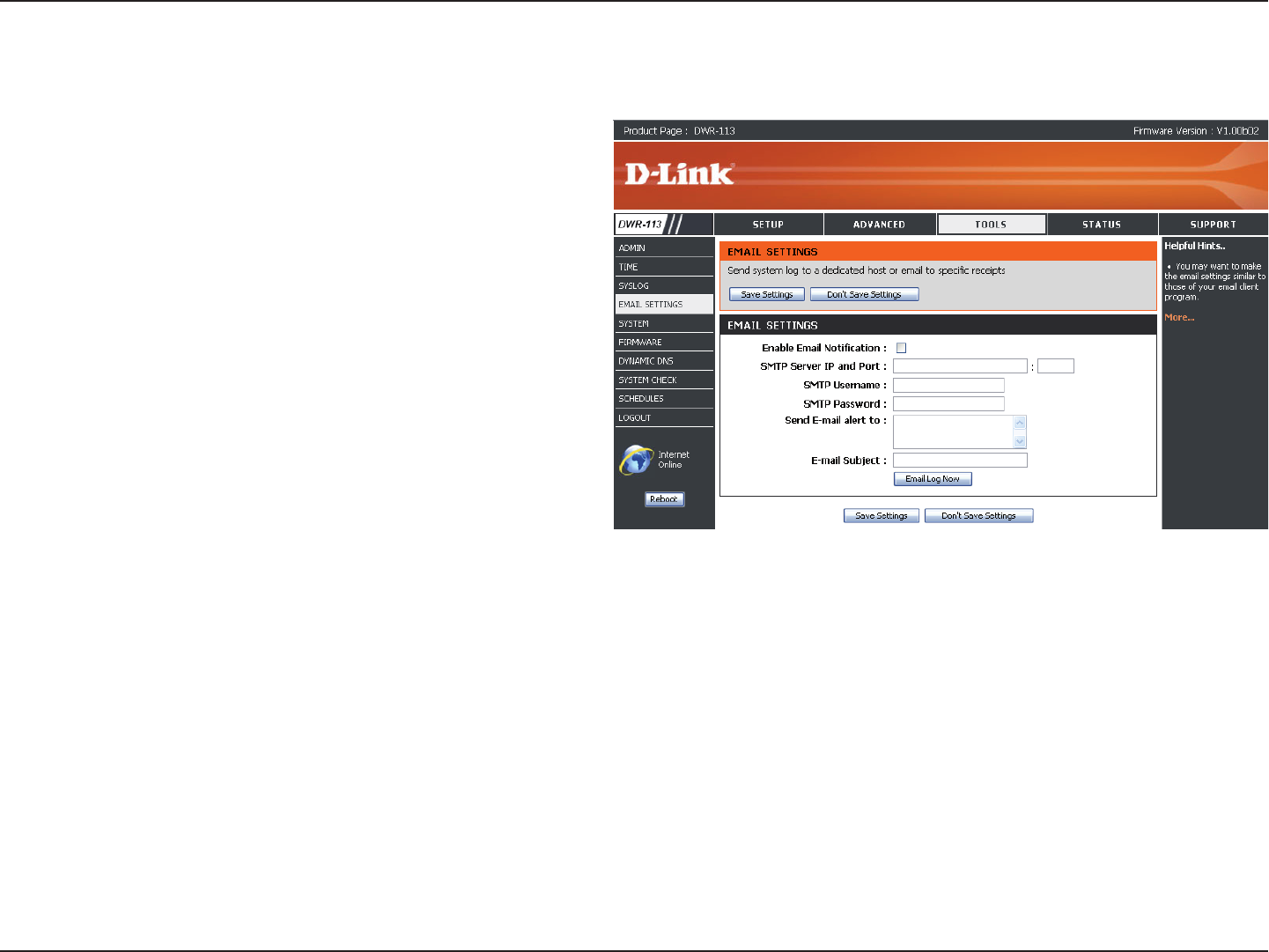
38D-Link DWR-113 User Manual
Section 3 - Configuration
E-mail Settings
When this option is enabled, router
activity logs are e-mailed to a
designated e-mail address.
Enter the SMTP server IP address
followed by a colon and the port
number (e.g. 123.123.123.1:25).
Enter the SMTP username.
Enter the SMTP password.
Enter the e-mail address where you
would like the e-mail sent to.
Enter a subject for the e-mail.
Click this button to access the e-mail log.
Click Save Settings to save your changes, or click Don’t Save Settings to discard your changes.
Enable E-mail Notification:
SMTP Sever IP and Port:
SMTP Username:
SMTP Password:
Send E-mail Alert to:
E-mail Subject:
E-mail Log Now:
E-mail Settings allows you to send the system log les, router alert messages, and rmware update notications to an e-mail address.